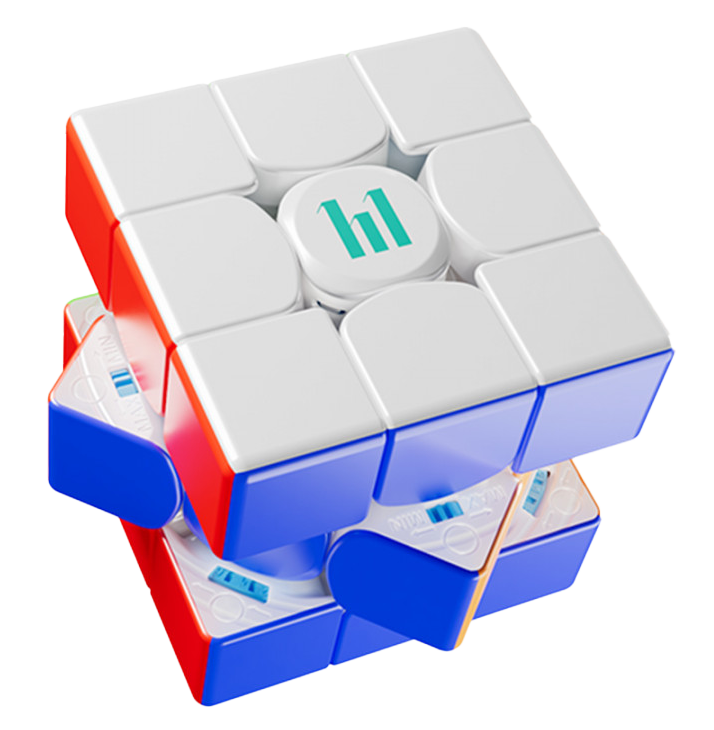Bas's cube reviews
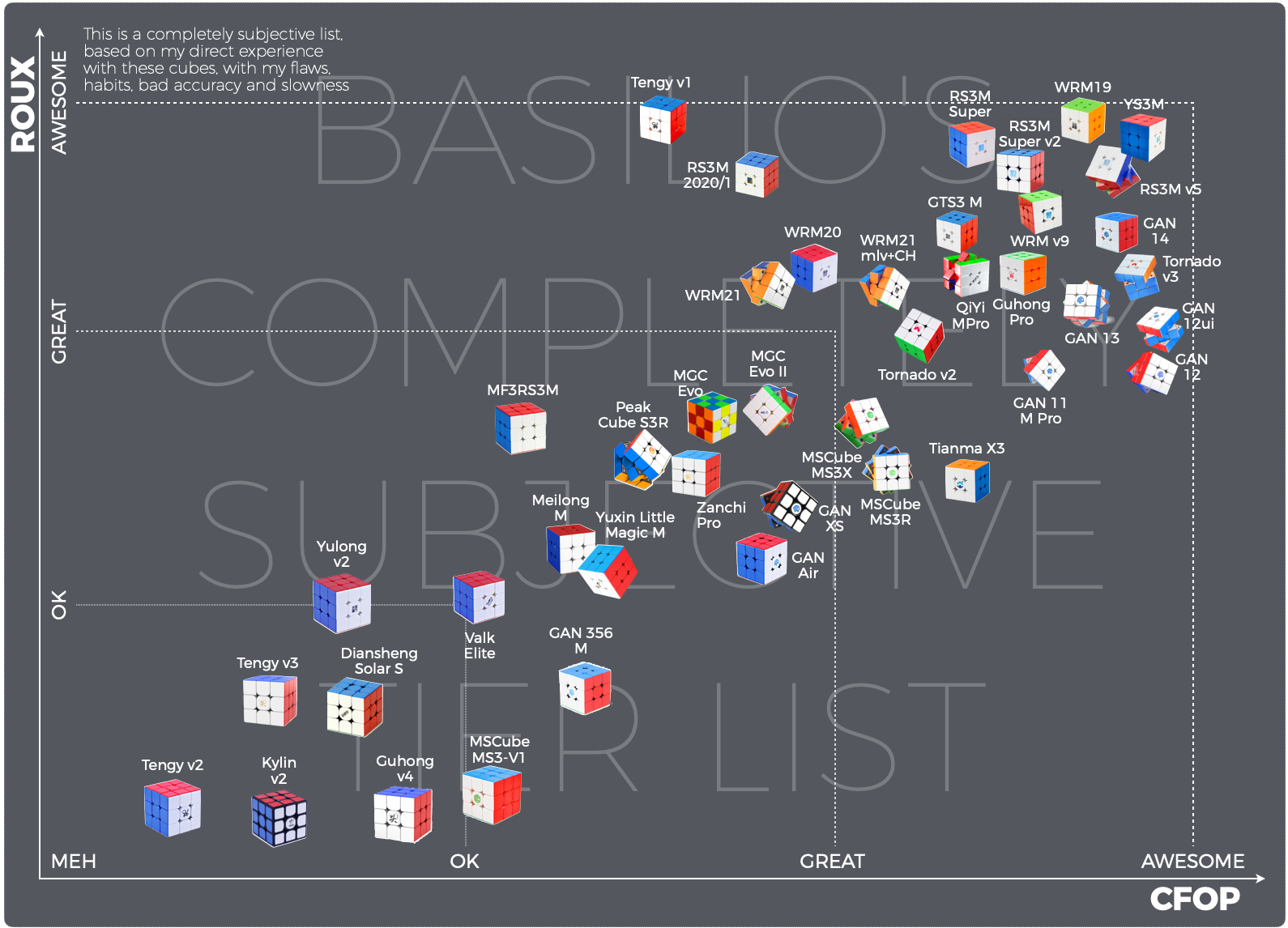
My tier-list is based on my personal
experience with the cube, after setting it up and playing with
it for multiple days. I separate CFOP and Roux because the
features that might work on one method might not be the best
for the other, and there are cubes that excel in one while not
being great in the other. Please note that while reasonably
fast for my four decades of age I'm average compared
to most in CFOP and bad in Roux, so take all this
with a grain of salt!
And with that out of the way, on with the
reviews!A hopelessly subjective assessment of cubes from an average cuber
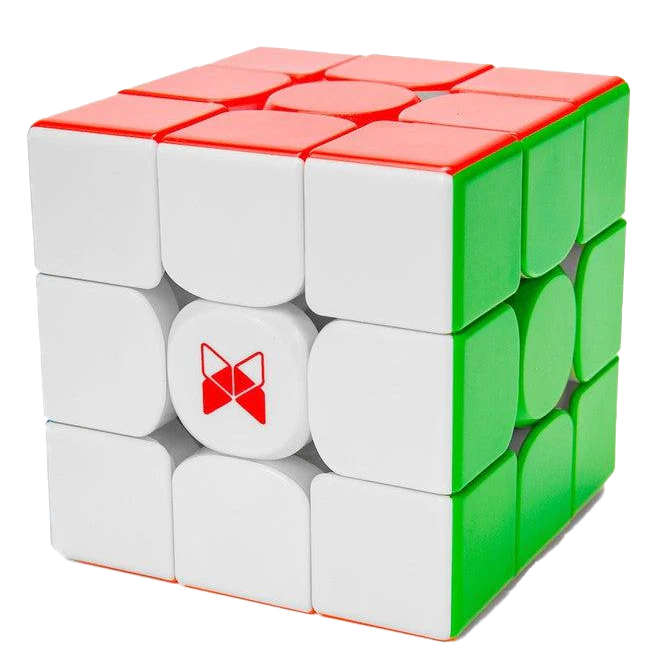 |
X-Man XT3 v1 – So, so fast... and unforgiving
|
You’re still here? Then know that the XT3 v1 – obviously the first name to come to mind for a new and improved version of the Tornado v3 – is probably one of the fastest, lightest and best performing cubes that money can buy right now. Take the Tornado v3, take away its compact softness and its very generous forgiveness for bad turning, and replace them with pure precision and speed.
The result is a cube that will get you PBs out of the box, and make you feel like any of your other cubes have been dipped in molasses. The turning feels very sharp and accurate, the weight is very light, as is the amount of force needed to start a turn. The magnets have medium-low strength and are (sadly) non-adjustable, and the tensioning system goes back to the basics of a screws and a compression ring. However, this is not a tuned-down version of a better cube. This is an optimised one, where the useless parts have been taken away to keep what is essential to make the cube as good as it can be.
In terms of looks, this one is indistinguishable from the Tornado v4, you actually have to look at the edge magnets (1 vs 3, non-adjustable vs adjustable), or take out the center cap to see an old-school screw head instead of the very nifty, 21st century tool-less adjustment of the Tornado v3/v4. In terms of sound, where the V4 takes us back to the stealthy quiet of the v2, the XT3v1 sounds louder and more hollow, very much in line with the v3, if not even a bit noisier.
It’s not a cube for everyone. If you’re learning to cube and need something a bit forgiving that will let you get away with rough handling, incomplete turns and excesses of force, then go grab the Tornado v4 and leave this beast dormant. If you’re in your early days of learning, this cube might actually make you like cubing a bit less, as it will screw up your solves, make unexpected and unplanned turns and bring other misfortunes to your cubing sessions. If you like to take the difficult road, it might be ok to take a cube that forces you to be very light with your fingers and will not make allowances for you when you don’t. But then again, it’s better to get a more lenient cube that will give you faster times and fewer frustrations.
But if you’re able to appreciate very light, fast, accurate cubes, then you’ll just be in awe of a cube that doesn’t necessarily feel great (I personally don’t like the feeling of the turning very much) but will just get you ridiculously low times (you can't argue with results)!
So… Should I?
Well, it costs less than the V4, and it’s a ridiculous cube if you can manage to use it. If you can’t, you’ll hate it. If you don’t know whether you like really fast cubes or not, then you probably shouldn’t buy it.
TLDR: A hyper-tuned cube that is as fast and light as it is unforgiving to novice mishandling
- Weight & feel – Very light, and quickly
goes brrrrrrrr
- Turning Speed –Very fast, very light, very precise
- Corner Cutting – Eh, pretty good if you
finish your turns reasonably well
- Magnets – Non-adjustable, medium-light, sometimes
fail to keep the non-turning faces of the cube from turning
- Lockups – It won’t lock-up, ever, but will turn other
faces that you weren’t intending to turn
- Sound – Just as loud as the v3, if not a smidge louder
- Looks – Functionally identical to the v4 except for
the triple-magnet edges
- Plastic – Light and slightly hollow, UV looks great
- Similar-feel cubes – Tornado v3, Tengyun 1
- Price – 18-25$
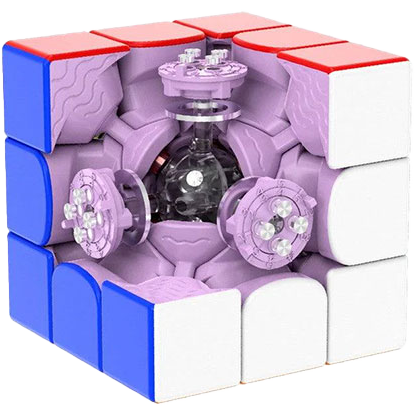 |
Dayan Zhanchi v5 – The quietest cube of the past 4
years, with the best customization range of this
generation
|
The nominal successor to the Zhanchi Pro, properly named Zhanchi v5 (I don’t even…) is a keeper. For those of us with the attention span of a Monday morning doomscroller, this cube looks great, is the quietest cube to come out since the Tornado v2, retains the adjustability excellence of the ZP and has pink internals. Yes, pink internals. You know a cube is going to be great if it has pink internals. (Well, it’s more of a purple-pink, but my point stands).
The outer design is the very squarish look of the Zhanchi and Guhong, the logo is red and for once it’s not an ugly sticker. Which… might be a bit of an issue : the embossing on the logo is very thick, and you feel it very strongly when you touch the cube. If you’re interested in blind solving, this is not a cube that will be comp legal by any stretch. And its a tiny bit off-putting as it feels as if some of the things that sometimes grow on the horizontal jungle that I call “my desk” had stuck to the cube when you pick it up (yuck!).
The outstanding feature of the cube is how quiet it is. We haven’t had a quiet cube in a very long while. To date, the most silent cubes were still the XMan Tornado v2 and Dayan Tengyun v2 (with the Tengyun v1 being relatively quiet but not to that level). I might need to audio-test this one but it feels pretty darn close to the Tengyun v2 in how quiet it is, which is a fantastic boon for people cubing in public or during zoom meeting where they should be paying attention instead. Very low pitched and papery, the sound is not only not loud, but it’s also not unpleasant to hear.
When it comes to customisation, Dayan pulled a fast one again. Younger cubers might not remember the very convoluted “switch axis” tensioning system of some older Dayan cubes (Tengyun v2, I’m looking at you). This is to say that Dayan’s team has a venerable tradition of adding unnecessary complexity for absolutely no reason or effect. This time around, their brilliance is showcased by the idea of having 4 different strengths for so-called “Axis Magnet Components”, which are swappable nuts that sit on top of the center pieces pointing towards the center cap. This adds a slight pull so that when the face is oriented towards the 90° angle, the magnets will pull a bit. Now, it’s been a while since my electromagnetism classes during engineering graduate school, but the only purpose I can understand from these magnetic nuts is to strengthen the already existing pull of the corner-core magnets. It’s not a great solution but at least it is “a” solution… to a problem that could have been solved by just having stronger magnets on the core, or a higher range of movement of the core adjustment (more below). To be fair, producing 96 additional magnets for every cube sold instead of coming up with a good center cap design, means that the engineering team can show production costs that justify keeping them employed. And the marketing team can feel good about putting the cube at its somewhat high price point.
With that said, the level of actual customisation that can be had is pretty nice : being able to adjust the corner-core magnets is nice (although having to disassemble the cube to do so is a bit annoying, especially when many other manufacturers let you do it from the sides of the corner pieces themselves); so is the rather broad range of strengths on the edge magnets. In a market where so many cubes are reducing the adjustment options so they can sell several versions of their product, it’s very refreshing to have something that harkens back to the golden age of customisability. Add in a well made 2-direction tensioning wheel and you have a cube that begs to be tried at very different settings.
And… it works : the range of stability and feel that is achievable is really broad, going from very fast and flexible to tight and controllable, and I truly invite you to spend some time fiddling with the settings. They do make a noticeable difference and they will let you get something that truly works for you. The cube’s predecessor was already a true example of how adjustment should be made, and this one continues on that nature.
The result is a cube that will work very well for you if you make a minimal effort to tune it to your liking, it looks excellent (have I mentioned it’s pink?), it is one of the top 3 quietest cubes of this decade and is going to make a lot of people happy. Give us blank center caps and I’ll be a very happy cuber.
So… should I buy it?
Short answer? Yes. Longer answer? If you’re tight on budget or don’t want to spend some time fiddling with the adjustment settings to find something that works for you then avoid it : if the default settings don’t work for you, you’ll have a hard time liking the cube and be disappointed. But if you’re a serious cuber that likes to find something that fits their style well, this is definitely a cube that you should have and play a bit of time with.
TLDR: It’s pink! Also it's super quiet, and has a ton of customization. Also it's very good!
- Weight & feel – Light, with solid pieces
that don’t creak
- Turning Speed – Very variable from moderately fast
to more controllable
- Corner Cutting – Very good on most settings
- Magnets – Very variable from very weak to pretty
strong
- Lockups – On looser settings it has that
loss-of-cube-shape that happens frequently on Dayan cubes
- Sound – QUIET! Definitely in the top 3 quietest cubes, definitely the quietest modern cube
- Looks – The squarish "sharp" look of Dayan cubes from
the past 3 years
- Plastic – Sharp, solid, glossy
- Similar-feel cubes – Very variable depending on
settings
- Price – 26-32$
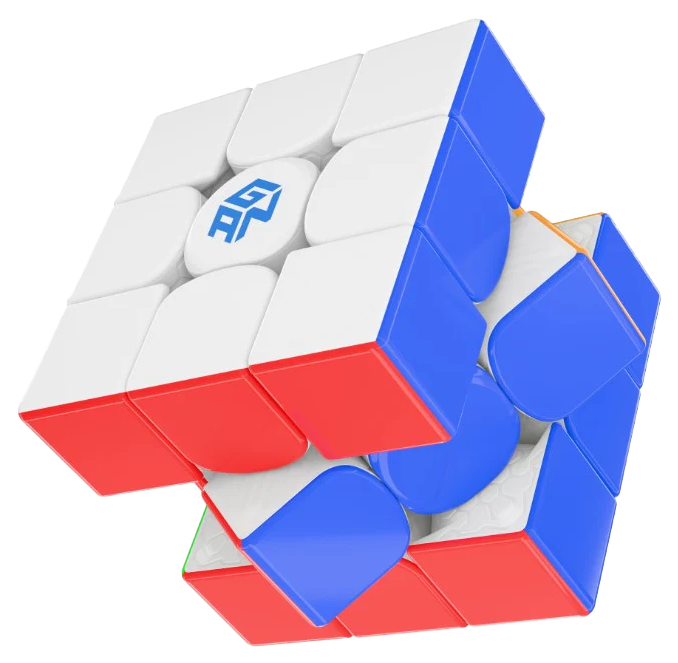 |
Gan 15 – Battling to reclaim their former glory?
|
After being at the top of the cubing food chain for ages, revolutionising again and again the hardware, the swappable springs, the core-magnets, the ultra-light plastic. All these advancements and improvements establishing them as the brand that costs a truckload of money, but gives you the best cubes that one can buy. The Apple of cubing (if Apple made computer that were objectively better than the others). The younger among us do not realise the steep increase in quality every time GAN had a new release. All of this cresting on the release of the Gan 12 M Pro, a cube that took the revolutionary feather-lightness of the Gan 11 M Pro and fixed its locking issues, making it one of the top 3-4 cubes that one can buy even today.
And then, much like the inhabitants of the land of calves must have felt after the fall of the Roman Empire, they had to stare forlornly at the lukewarm reception of the fruits of most of their efforts of the past few years. Maybe they were victims of their own success, creating unreasonable expectations from a public that was going to be disappointed in slow incremental improvements. Maybe they were just happy with coasting on the brand equity they had built knowing that people will buy their products anyway. Or maybe they just ran out of ideas.
But seeing a lack of excitement on their GAN 13 and questioning frowns at their #14, with most people saying “yeah, well, I’ll stick with the 12 thank you very much”, must have prepared them for what is likely going to be the reaction to their latest release. And…. they’re probably right. The GAN 15 is an excellent cube, functionally indistinguishable from the 14, which was incrementally better than the 13. And it’s still not as good as the 12.
The newest GAN sports the same lightness of touch of all GANs since the 11 barged onto the cubing world, some of its crunchiness, but not a lot of the sharp precision that makes the GAN 12 the beast it still is. The result is a cube that is a bit soft to turn, a bit elastic, loses a bit of its shape here and there, is very good for TPS and not so great for slice-heavy methods like Roux.
The plastic is the “new gan plastic” introduced in the 13, more solid, less fragile and hollow than the see-through gossamer cloth that covered the 12. This means fewer risks of breaking things if you open up one of the pieces, and less of that creaky noise you get if you squeeze the 12. The pieces are still hollow, and the cube is ridiculously light, but it does feel just as solid in the hand as the 13 or 14.
The magnets are on the mid-weaker side, and the lack of customisation (which made the GANs stand out from the new trend of making four versions of the same cube instead of one cube with adjustable settings) is a regrettable omission, especially as it doesn’t allow you to get the traditional GAN clickiness that is cherished by many.
The performance is excellent. Let me re-iterate that this is not a bad cube at all, it’s likely one of the best cubes on the market today. It’s simply not as good as its predecessor from – by now – 3 generations ago, or as something like the Weilong Super (which in contrast to the GAN 15, does manage to provide the sharp crispiness of the GAN 12). In return, it is a bit more forgiving, and showcases fewer of the “almost lockups” that the GAN 11 and to a much lesser extent the GAN 12 were known for. I’ve been getting excellent times with it, and solving for hours on end is effortless, but it’s simply not a very memorable cube, to the point where I’m mostly unable to tell the GAN 14 and 15 apart without looking at the presence – or lack – of the magnets adjustment.
So… should I buy it?
The short answer is… probably not. You can buy a Gan 12 for less money and will have a better cube that is more customisable and faster. Chip in more money (it’s a GAN, we’re not here because it’s cheap) and you can get a GAN 12 ui which is a better speed-cube than the GAN15 and is a smart-cube to boot. Or for the same price you can buy a Guhong Pro, a QiYi M Pro v2 and a RS3M v5 combined. Are they better cubes? Not really, but then again if you want the best GAN, the 15 is not the one you would want.
TLDR: It’s a GAN 14 without magnet adjustments
- Weight & feel – Light, with solid pieces
that don’t creak
- Turning Speed – Fast
- Corner Cutting – Ridiculously good when
loose, perfectly good when tightened down
- Magnets – On the weaker side, non-adjustable
- Lockups – A lot fewer than on previous versions
- Sound – Loud! Not as crunchy as the 12 but still significantly louder than many cubes
- Looks – Can’t really tell it apart from the 14 or 13,
but if the look works why change it!
- Plastic – Sharp, solid, UV glossy, stellar moulding
quality
- Similar-feel cubes – Gan 13, Gan14
- Price – 65-70$
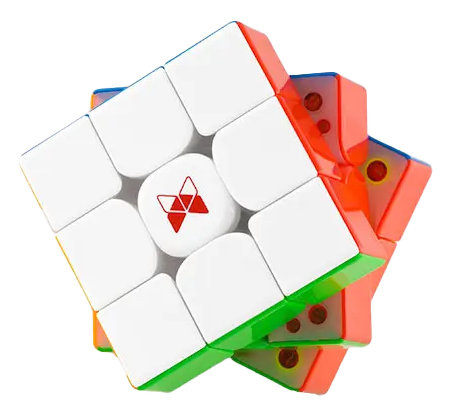 |
Tornado v4 – Something old, something new, something
borrowed, and still the most kickass adjustment system
|
The Tornado v4 once again comes in a couple of flavours, but in both cases you’ll be happy to discover a cube that not only brings back the very forgiving, very fast, very light performance of the V3, but also pulls out of the grave some of the silent smoothness of the v2, and provides adjustable magnets that can go a bit weaker to not feel as clicky as the v3 used to be, all this in a slightly smaller package.
The pieces retain that filled solidity that is in strong contrast to the flexible thin layer of plastic that GAN uses, or the somewhat mushy feel of Moyu cubes (try squeezing the E-slice edges of a Moyu from home grip and you’ll see what I mean). Build quality is fantastic, with no moulding seams and flawless UV coating, and the design is pretty much identical to the former models. The caps are still sometimes blasphemy-inducingly fun to take out, but at least a very convenient blank cap is provided for people who like to bleed, sorry, BLD with their cubes.
The adjustment system remains the stroke of genius that X-Man brought to a world of eternal doofus-shaped plastic screwdrivers, harpoons, katanas or whatever the hell GAN fire-hydrants are supposed to be. Back is the tool-less adjustment, with bi-directional wheels and matching colours to make it really easy to understand what settings you have even for people without the retinal resolution still common among median-age cubers. By now many other have copied part of the system so the younger among us might not realise how revolutionary an idea it was (and still is), so thank them for being brilliant, then tell GAN that they might want to borrow a leaf or two from XMD’s engineering team.
Everyone knows that having more of something is always better, so XMD’s engineers decided that this time it was going to be magnets. And given that we’ve basically put magnets on any surface and sphincter the cuber had to provide, edges now have THREE magnets on each side, with a big attracting one and two small repelling ones. Does it make sense? Eh. Does it look badass? Definitely. Does it make the overall feel of the magnetic click less tactile? To some extent probably, or it might be a better adjustment of the core-corner magnets, or the overall internal friction of the pieces. Or maybe my Tv3 is so worn out that anything new feels like such a great improvement. (Note, the Pioneer is the only one that has the 3 magnets on the edges, and it’s UV, so it’s necessarily better)
Tensioning is a bit less generous than it used to be for newcomers : make it a bit too loose and you’ll be popping pieces at an annoying frequency. But given how easy and effortless it is to adjust tension and travel distance on this cube (that is, once your fingers don’t bleed anymore from trying to take out the center caps), you really owe it to yourself and the cube to find a setting that works for you. And once you do, you’ll have a cube that never locks up, never catches, and lets you get away with stuff that would have most Dayan cubes look like the worst nightmare that Cubists have painted this century. (A note : invest some time on finding the right balance for tension, as it can quickly start to feel too tight and give you the impression that this cube is slow. It isn’t!)
The cube is also smaller than the v3. While the specs theoretically say 55.5mm, the reality is much closer to 55mm (at 55.1mm on the center caps), making it much closer to what most cubes have become of late, much to the delight of people who like me have chubby sausages instead of fingers.
Overall the performance of this thing is fantastic, and if you haven’t just gotten an XT3v1 then you might want to give this a try. XMD doesn’t release as many cubes as some 4-letter brands are able to secrete each year, and when something comes out one should notice, and this cube is worth noticing!
So… Buy?
Yes. If you haven’t broken the bank during the pre-holiday/holiday season, then you probably want to have this cube in your collection. If you need to choose one version, pick the Pioneer… or was it the Flagship… ask around and everyone will tell you that one of them is absolutely better than the other, and you should listen to them because they definitely know what they are talking about… (more seriously, get whichever you want, they’re both perfectly fine)
TLDR: An iterative improvement on the Tornado v3 with some elements from the v2, more magnets and a smaller size
- Weight & feel – Average weight, the
pieces have a “filled-plastic” feeling when turning
- Turning Speed – Fast, but very controlled thanks to
core and triple-edge magnets
- Corner Cutting – Fantastic
- Magnets – Less than on the v3 but still rather clicky
- Lockups – It will pop before it locks, unless
tensioning is too tight
- Sound – Less loud than the v3, albeit not as quiet as the v2
- Looks – Functionally identical to the v3 except for
the triple-magnet edges
- Plastic – Sturdy and sharp, glossy (yay!), with
pieces that feel thick and solid.
- Similar-feel cubes – Tornado v3, Tengyun 1
- Price – 30-45$
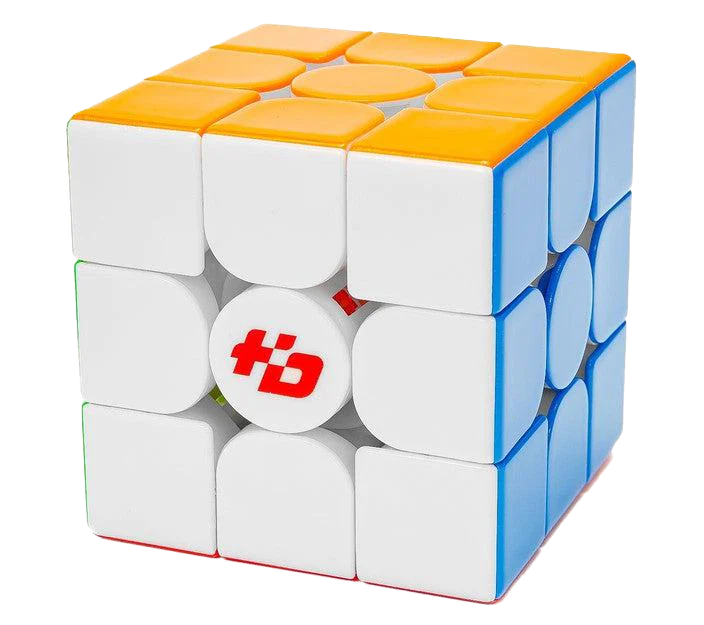 |
Fanxin Hudong Light – At least they’re trying new
things
|
For those of us with very short attention span, one might be tempted to say that they should probably go back to fruits.
The Hudong is by no means a bad cube. It is pretty quiet, with a papery, low pitch that makes the sound more pleasant and less distracting than the auditory crimes that GAN or QiYi manage to produce. Its turning is very light, and the pieces have a hollow solidity that reminds of the Valk Elite (though less crunchy if you squeeze it). The magnets are rather strong (I had the Ultra version with core magnets), but combined with a very strong auto-align, that means you’ll be very accurate.
The plastic feels solid, and the build quality is a notch above most cubes (no moulding seams, flat corners without creases). The design is at least a bit different from the myriad of cubes that all attempt to be clones of the design that Gan introduced years ago. The round center cap looks goofy but not too bad. It does have an unfortunate design flaw : The round shape creates bigger holes on the inner slices of the cube; holes in which the skin of your fingertips will sink in, and proceed to be poked and cut by the sharp point of the corners. This is only mildly annoying at first, but can start to chafe if you solve for a long time.
In terms of actually solving with it, it’s a perfectly fine cube. Very controllable, and with the strong auto-align, the cube feels very sharp and sturdy, like a slow version of the Tengyun v1. The surface friction feels scratchy even with Dayan-worthy amounts of lube. Add in the fact that the cube actively tries to bite you and the solving is not necessarily a superb experience. But I did get mostly similar times to what I usually get with newer cubes.
So… should I buy it?
If this costed 12 or 15$ it would be good as something to try out if you’re bored of the usual brands. But it costs more than most cubes and does not bring anything new (or at least new AND good) to the scene. If you’re looking for something silent, this cube is one option. But then again so is the Tornado v2, and even with its age it remains a better cube.
TLDR: A quiet, rather good cube that should cost half its current price
- Weight & feel – Average weight, a bit
scratchy even with lube
- Turning Speed – Moderate to Fast
- Corner Cutting – You'll never need it with
the strong auto-align
- Magnets – Strong, non-adjustable
- Lockups – Not so much (again, thanks auto-align)
- Sound – Pretty quiet, and with a low soft register, making it a good cube for solving in public spaces
- Looks – The round center-caps look a bit goofy, but
the overall design is different from the unavoidable “gan
look” of 95% of all cubes released these past 2 years
- Plastic – Sharp, a bit too sharp. The internal
corners on the edges can hurt your fingers when solving, very
good moulding quality
- Similar-feel cubes – Valk Elite
- Price – 20-30$ depending on version
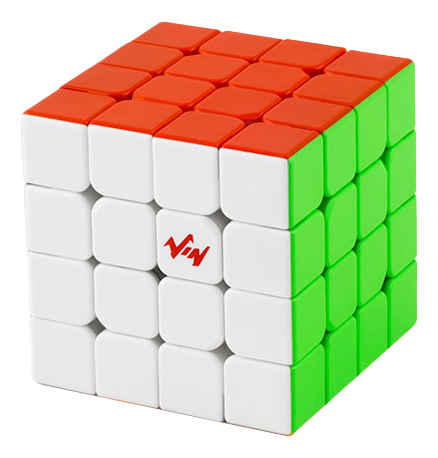 |
VIN Cube – You can be fashionably late, but sometimes you’re just late. |
Had I reviewed this 1-2 years ago, it would have been a banger of a cube, and a strong contender for best 4x4 alongside the (older) Aosu. The new release from Moyu and the spectre of Gan potentially making a new market-breaking product as they did for 5x5 means that the VIN Cube is probably not the thing that you might want to buy right now — Let's see how badly this sentence will age : GAN might produce another profoundly underwhelming 4x4 just like the last time they made one and I'll look like a dumdum...
But with that out of the way, the VIN cube remains one of the best 4x4 out there, sitting in the middle of the “tight and solid” turning of a – say – Aosu/WRM, and the bubbly flexibility of the MGC. As I’ve never been fond of the elasticity of the MGC, the VIN feels like a good middle ground that could satisfy the people who find the Aosu too stiff.
The magnets on the outer slice are well balanced, but the middle slice feels a tad too clicky and strong. This is not really an issue for most of your solves (and it makes sure that you won't turn the middle slice by accident, but it does make some algs (e.g. OLL parity) a bit more bothersome. The auto-align from the ball-core doesn’t really complete turns for you, but it does make your turns land very precisely where you should, making lockups and pops almost impossible to get unless you’re really trying.
The plastic is solid and the uv makes it very shiny. The moulding quality is a bit wobbly which makes reflections look bubbly (especially on the corners). Nothing bad really, but it makes the cube look and feel like it costs about as much as it does.
The size is… big. While most other 4x4 have been going down in size, this one clocks in at almost 61mm, which is noticeably larger than the XMan, and older Aosu, let alone the new one. It is sufficiently big to be uncomfortable during the 3x3 phase of solves for people small hands, without really proposing much in return.
In terms of performance, I didn’t get anything particularly different from my older times, but neither did I get times that were particularly bad. My hands are small and chubby, so I fall in the category of “not really for me”, and yet this is a cube that let me get my usual times.
So, should you buy it?
If you have big hands, to the point that a 58mm cube is too smal for comfort, then maybe this is for you. If for some reason the stiff precision of the Aosu v7 doesn't click for you and you want something a bit more bubbly and flexible (but not as much as the MGC), then maybe give this one a try. It has the benefit of not breaking the bank, but the ball-core version (the only one really worth getting) is still not that far below the price of the Aosu, so not a true argument for not getting it instead.
TLDR: A good attempt at putting modern hardware on a 4x4, the result is a good cube that feels better than most of the 4x4 from the past 5 years, but not as good as the best ones. It might be good for people with gigantic hands or for people who really like the MGC but are tired of getting pops.
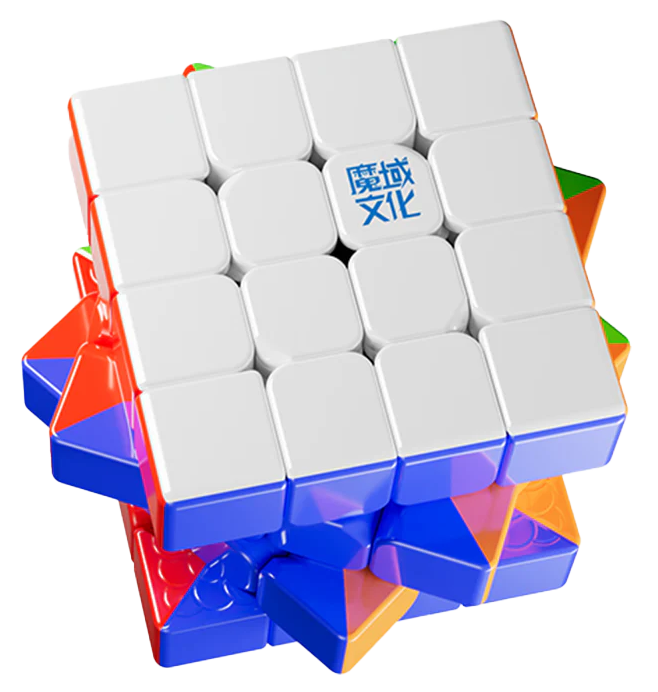 |
Moyu Aosu v7 – Well, at least it's Xmas so you have a good excuse to get this cube |
We don’t have a lot of new 4x4 each year; rather, we count them in “new cubes per lustre”. And indeed in the past 5 years we haven’t had a ton of them. Most people have been either using the (old by now) Moyu AOSU for its solid reliability, or digging the small YJ Zhisu Mini for its size and flexibility, or getting the MGC for its performance vs price ratio. Not really a lot of alternatives have come out (and indeed the Zhisu mini was the most novel release that people actually liked, and is now starting to date a bit as well). So imagine the delight of discovering that Moyu was coming out with a new cube following the cherished tradition of taking a name and adding a random number between 1 and 20 at the end of it.
Enter the Moyu AOSU v7, which follows the… ehm... Moyu AOSU WRM? Ignore the name, and what you have is the best 4x4 to hit the market in the past several years. A cube that takes the stellar performance of its predecessor and namesake, but packages it in a mini-size volume (well, 2mm bigger, but that’s actually an improvement, see below).
The turning is very reminiscent of the previous Aosu, with a very controlled and sturdy turning (in contrast to the gummy elasticity of, say, the MGC).
The corner cutting is another thing that should make us pause : that we’re talking about corner-cutting at all for a 4x4 just shows to what extent the ease of solving is getting closer to the experience we can have with a 3x3. And while we're not talking about 45° yet (especially when turning the 2nd layer), the forgiveness of the corner cutting, combined with the auto-align of the double or triple tracks version, make solving this cube so much easier. This could make a world of difference for new cubers, who sometimes have unfortunate surprises when switching from the smaller/simpler events to 4x4 and realise that “Whaaaat? I need to actually finish my turns?”.
The size is also an important change and one that is truly for the better. The very success of the YJ Zhisu Mini was that its size allowed to perform 3x3-style last layer algs and double slices on a 4x4. The Aosu v7 goes a big step in that direction, but remains slightly larger (58mm instead of 56mm). While the difference might not feel significant, the slight extra space makes it very comfortable to do inner-layer slices even with chubby body-positivity fingers like mine, which was not a given for the Zhisu and was sometimes the reason for remaining with the larger cubes.
The magnets are very well balanced, with a slightly stronger pull on the central slice compared to the outer edge. This makes it very easy to switch from single to double layer turns (as well as full-slice vs quarter-slices). The double vs triple track versions do not really provide a true difference in feel or performance : the variability of setting up the cube to your liking (e.g. the amount / type of lube you put in) will have a much larger impact on how the cube feels compared to using a double vs a triple. (I couldn’t really tell apart the double and triple currently sitting on my table except by weighing them, and even there I couldn’t really tell by just holding them in my hand). I ended up keeping the triple on my bag, which has made it much more scuffed, and is now easier to distinguish. But if money is a concern, just go for the double, you won't be missing anything. As for the single track, I haven't been able to test it so I can only imagine the impact of not having a ball-core. Going with my experience with the older AOSU, that should still give you a plenty good cube, but I have the nagging suspicion that it might be worth shelling the extra 20$ for it (I know that it's basically doubling the price of the cube). But it's better to buy a great cube once than being disappointed with its dumbed-down version as it might not bring much new compared to the older brother.
The plastic feels solid and premium (the UV coating does what it needs to, i.e. it grips well from the get go instead of needing a period of getting to know each other) and squeezing the cube does not provide the mushy elasticity of the MGC or Zhisu Mini. Much as its predecessor, the Aosu v7 is almost impossible to pop, unless you loosen its tension by quite a bit. The sound is not quiet by any stretch, but it does not generate that el cheapo sound that annoys you as the solver almost as much as everyone else (MGC I’m looking at you).
In terms of raw performance, I beat all of my PBs within a matter of hours (from single to AO5 to AO100), which is a testament to how much better this cube is than (at the very least) the other 4x4 I had around (granted I hadn’t set them up in a while, and now there’s no reason for me to).
While we wait for the guys with the blue logo to release their new version of their 4x4, eager to see if they will pull off a miracle as they did with their 5x5, and open a new era of cube technology for 4x4 as well, you will not be doing any errors getting yourself an Aosu v7, whichever amount of tracks you end up preferring.
So, should you buy it?
If you're even remotely interested in 4x4, yes. If you like 4x4 but are not too invested in it, then get the Single Track version. If you're not interested in 4x4, then get it and offer it as a gift to someone who is!
TLDR: The best 4x4 available today, combining the best performance from its predecessor with a more ergonomic size much closer to the also beloved YJ Zhisu Mini.
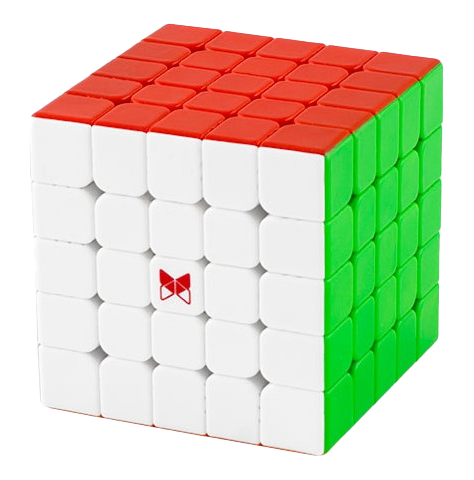 |
X-Man Hong – The best 5x5 you can get without selling your kidneys |
And… they would have blasted away any competition if their timing had been better. As it stands, their newest product shines at a comfortable 2nd spot, ahead of any cubes from last year of before, but not at the level of that very expensive one with the blue logo.
The Xman Hong is a really good 5x5 that feels like a normal 5x5 that performs really well. It is a bit springy and flexible, albeit not as much as the MGC, and has very differentiated layer magnets, with a stronger pull on the inner slice and a rather weak one on the outer layer.
The cube requires some setup (lube, maybe some re-tensioning, but I was pretty happy with the tension out of the box), but if you’re shelling out the cost of this cube you probably have some lube around and half an idea of what a cube that is too tight or too loose feels like. Despite that, I’ve been getting my normal times very quickly and very consistently after a relatively short time solving with it.
The only true flaw of this cube comes from the weaker outer magnets : they make slices fantastically comfortable, but the weaker pull doesn’t let you finish your turns precisely with ease, and the core magnets are unable to compensate for it. Factor in the flexibility of the cube and you might get slight catches and lockups, unless you loosen the cube and then might risk pops.This makes it sound as if the cube might be bad. It isn’t. Slightly catchy and locky cubes have always been the standard for 5x5, where corner cutting can only help so before pieces start to jump around like popcorn. Within the context of big cubes, this one is perfectly fine, it just requires you to be more accurate than the clumsy slob that most 3x3 will let you get away with being.
The comparison with other cubes is where the question of timing comes in: Had I been writing this review 4 months ago, I would have been raving about the new king of 5x5. More controllable than the MGC and without as many pops, more flexible than the Valk5, faster and lighter to turn than the WRM. It feels like it manages to get the right balance of many features that other cubes only tend to hit piecemeal.
But then there’s the new blue elephant in the room. The Gan 562 is just a different type of puzzle. Call it next gen, or very lucky happenstance, or the result of big investments and engineering, but the Gan just overperforms all the other 5x5 that are available, Hong included. Nevertheless, the Hong does have two advantages : Price and Size. The Gan costing almost one and a half times more than the XMan, means that many of us will have to consider whether to fork out the difference. The Hong being noticeably smaller than the 562 means that cubers with small hands might find their happiness here, and be able to execute some fingertricks that are more challenging on the larger and unwieldier contender.
As for the rest… in terms of design the cube looks ok. Some of the colours are more vibrant (orange, red), others are darker (blue, green). A very minor pet peeve I have is that the grooved pattern on the inner side of the edges (to keep lube in) are very visible even when the cube is solved. This creates small shadows between the edge pieces that make it look as if something is stuck in between. Add in the less than stellar tidiness and cleanliness I manage to exert when it comes to taking care of my cubes, and my Hong has quickly started looking a lot gnarlier than it really is.
So… should I buy it?
There’s no super easy answer. If money is not an issue at all, then I would just get the Gan : it’s a beast from a different planet. If money is not an issue AND you have a Gan 562 already, then definitely get this one, it can make for an excellent backup cube and you might discover that the smaller size and more flexible feel suits you well. If you’re just starting out but want to get serious about 5x5 then this is a great place to start while breaking the bank only up to a point. If budget is somewhat limited, then it is more of a challenging question : get the Hong for the price of 3x Zhilongs, or the Gan for the price of 5x Zhilongs, or the MGC for the price of 2x Zhilongs? The short version is likely "If you can't afford the Gan, get the Hong".
TLDR:The best 5x5 available without breaking the bank (too much).
Flexible but not overly so, fast but controllable, its performance is marred only by weak outer-layer magnets that don't help you finish your turns as easily as they probably should.
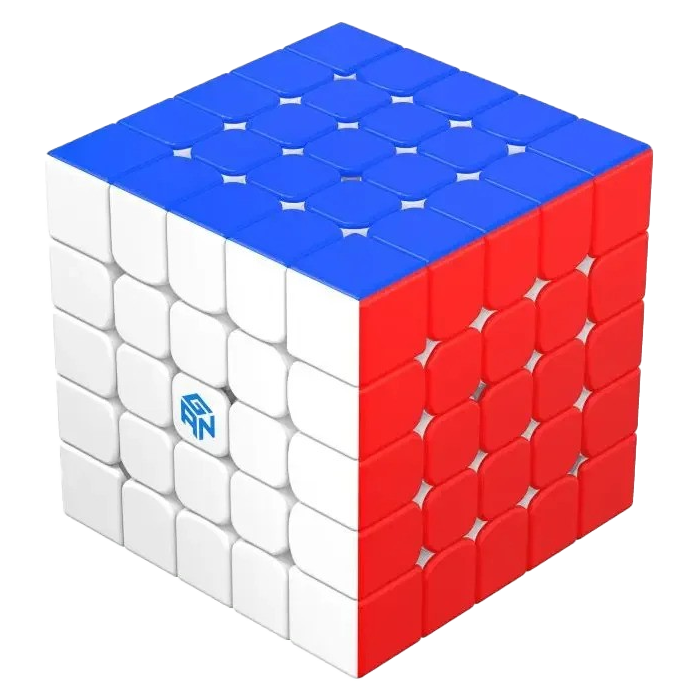 |
Gan 562 – GAN, you rascals, are you planning to
conquer the large cubes market too?
|
Large cubes (anything from 4x4 upwards, but more explicitly 5x5 and up) have been very simple to understand and recommend : “Get the MGC” has been the obvious choice for almost anyone, and for those truly invested in the event, there were some other options (Valk, Moyu WR M or Shadow/Spark for bigger cubes), but the MGC has been the most owned cube for most events for the past couple of years. Some cruel voices (…cough… such as mine…) may suggest that all the engineering efforts and brain power of the MGC line went to all the “side events”, as their 3x3s tend to be forgettable at best, downright nasty at worst. For a brand that so clearly dominates almost all events, it is surprising they might be that unimpressive on the main one.
On the opposite side of the same coin, GAN has been at the top of the 3x3 charts for so many years, that it was very surprising how unremarkable (or downright terrible) they were at all (most) other events. However, this has started to change very dramatically the past couple of years. Their branding hasn’t changed, and you’ll be paying a premium for their puzzles that could instead be invested into purchasing two cubes from any other brand; but you know you’ll be getting good stuff now.
The Gan 562 is no different.
Mind you, making a distinctive 5x5 should not be that hard, as there’s only a handful of (recent) puzzles that are worth considering. Besides the unavoidable MGC, the Zhilong/Zhichuang mini – which is ridiculously good for a cube that is supposed to be a chibi version of a real cube – has been a very surprising and very welcome arrival : having the possibility of executing 3x3-like fingertricks on larger cubes is very appealing, and for people with smaller hands (quick glance toward my stumpy fingers), the mini 5x5 by YJ works really really well. However making something distinctive AND good can be more challenging.
Both the MGC and the Zhilong are pretty “elastic”, with a bubbly plastic and way of turning that works well, but cannot really be dubbed “stable”. Tighten them too much and they become unwieldy. Loosen them too much and they rapidly devolve into a Micheal Jackson compilation album. They remain excellent cubes for a 5x5 (pretty much the best ones up until a couple of weeks ago), and definitely a great choice for people preferring something more flexible and springy. While we’re on this YJ tangent, besides the obvious size difference the Zhilong and MGC also have some other differences, such as different magnet strengths for the different slices on the MGC vs equal-strength magnets on the Zhilong, but overall they are not too far from each other in feeling. (I get similar times on either, but actually find the Zhilong easier to set up.)
The Gan5, in contrast, is the most controllable and surgical-feeling 5x5 I’ve tried. The cube feels very sharp – the design with its flat bevels helps that – and is very stable even when loosened a bit (the default settings are definitely too tight). The magnets are rather strong on the middle slice, making M and S slices very easy to make, and slightly weaker on the outer ones, but still strong enough to keep things together well and help finishing turns precisely, letting you avoid needing to corner-cutting in most situations. Not that corner-cutting would be an issue: it is very snappy and very generous for a 5x5 that won’t pop every 3rd solve. The size and weight are very comparable to the MGC and solving for hours will not feel like a strain. This is a really good 5x5 that feels like a really good 4x4 rather than a traditional 5x5.
I’ve beaten my PB single, AO5 and AO12 within hours of getting it (mind you at my speed that is not saying much), and from the experiences of people around me, it feels like this is a cube that people will instantly fall in love with (or instantly find profoundly meh), which again is something different from the experience of older 5x5s that had to be well broken in before one could truly make a good judgement on how they fit their solving style. It clearly feels like a premium cube (in contrast to the MGC, which despite its fantastic performance still feels like a cheap piece of bubbly plastic) and makes me want to do more 5x5 because it’s just fun to solve with it.
The only gripe I have is that Gan likely underestimated their own success, and produced only a smattering of UV-coated versions, which meant I only could get a frosted-plastic one. It’s perfectly fine (frosted plastic on big cubes is not as much of a drawback as in smaller ones), but dayum if I wouldn’t have loved it even more as a shiny, bright beacon of colored glory. And talking of glory, the cube box is just badass, and adds to the feeling of premium that you get from investing your entire weekly allowance into it.
Should you buy it?
If you’re anywhere close to serious about 5x5 yes. Forget the cost, there’s not enough good 5x5s to let this one go, and this one is at the top of the list of the good ones, and will likely fit you better than your MGC or Valk do. If you’re only mildly interested in the event and already have an MGC, AND you like your MGC, then this might make you more interested in the event (this thing feels awesome to solve on!). If you’re not into 5x5 at all but want to start, then it’s a bit more difficult to justify paying 2.5x more for this one than for the MGC. If money is not an issue, however, or if you want to give it as a gift, I’d give this one a go. And the fact that with all of this, this GAN costs only half of the price of their flagship 3x3 is just a cherry on the cake.
TLDR: The best 5x5 available today, unless you prefer flexible, bubbly things.
It's a bit pricier compared to the other 5x5 worth considering, but nowhere near too expensive for you to avoid it.
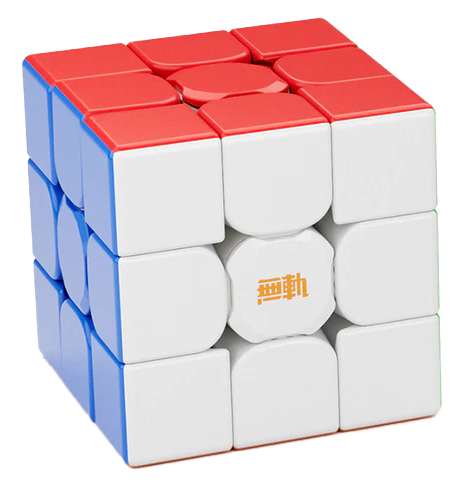 |
YJ Appari – They tried to do something, they failed,
and the result is a good cube!
|
While that is apparently not happening, at least it provides us with some fodder for questions such as “who thought that THIS was a good idea?”. The YJ Appari is no different, and this time around YJ decided that it was time to reinvent the wheel (almost literally):
For more or less as long as we’ve had springs inside our cubes, we had a very simple solution to avoid having the spring scraping against the head of the screw or the bottom of the center piece casing. Put a washer in it. For non native-speakers or clueless friends among us, a washer is that small, flat ring of metal that you usually put between a screw and a hole, or in this case, between the spring and the parts the spring will scrape against. This reduces friction and is a light, very cheap and simple solution that’s been around for the better part of a millenium (or at least since the 14th century).
Then someone at YJ must have asked “Can we reduce the friction on the washer?”, and instead of asking “But… why?”, or to be slightly more forgiving “Can’t people just put a drop of lube on the screw hole if they feel that it’s making noise?”, the rest of the team apparently said “oooh I know how, and it’s a marketable idea!”. The result is a ball-bearing system ON THE WASHER, that plays exactly zero role in the performance of the cube. Replace the ball-bearing system with a normal washer and you have exactly the same cube, minus a bit of doofusness. The idea is so brilliant that even YJ’s marketing team wasn’t exactly sure how to market it, and the final name and explanation of what the “speed micro-actuator” is supposed to be and do is baffling to say the least.
But despite all of this, the cube is, in fact, pretty good. It’s heavy for a modern cube, and while the plastic feels solid, the sticker looks like something from one of the really cheap cubes from 5 years ago. But the core-corner magnets are helping making it very smooth; the dual adjustment (screw + compression) let you play around with tension settings much better than on previous YJ cubes; the magnets, while somewhat clicky in feel, are not a barrier to turning fast if you want; the design is a bit different from most cubes, with concave center-caps that are not as ugly as they could be (EVO I’m looking at you); but more importantly, the cube performs really well.
Most people might have to loosen the screws a bit from factory settings, but overall this is a cube that works very well out of the box without needing to break it in (just put some lube in it as this cube is about as dry as reading the contents of the almost-non-existent manual). But after minimal setup I got some pretty good averages within my first AO100, and once I got used to it I was able to get pretty close to my PBs.
So at the end of all this, despite all its efforts to put a needless gimmick that has absolutely no impact on the performance of the cube, YJ finally HAS managed to make a good 3x3. The tweaks in design that the engineering team probably sneaked in by ruse or by error make this cube a somewhat heavy, but pretty good cube that will please fans of solid, slightly hollow cubes like the Tianma or M Pro.
Should you buy it?
If you’re tight on budget, or just want to have the best cube around and not try other things, then this one might not be for you. But if you are tired of getting slight variations on the same cubes and want to try out something new, or are a fan of YJ’s big cubes and want to support them, then this is not a cube that will displease you.
TLDR: The ball-bearing stuff is dumb and utterly pointless. But it's by far the best 3x3 YJ has done in recent memory
- Weight & feel – Heavy, with solid plastic
- Turning Speed – Moderate to fast
- Corner Cutting – Perfectly fine, the
auto-align from ball-core makes it very hard to need to corner
cut
- Magnets – They feel stronger than they are, but work
pretty well for its speed
- Lockups – They don't really happen
- Sound – Moderately loud, with something of a resonance from the hollow plastic pieces
- Looks – Sharp, with very distinctive center caps that
make it look different than the plethora of gan clones that
abound nowadays
- Plastic – Sharp, solid, and shiny
- Similar-feel cubes – MoreTry Tianma, QiYi M Pro
- Price – 15$
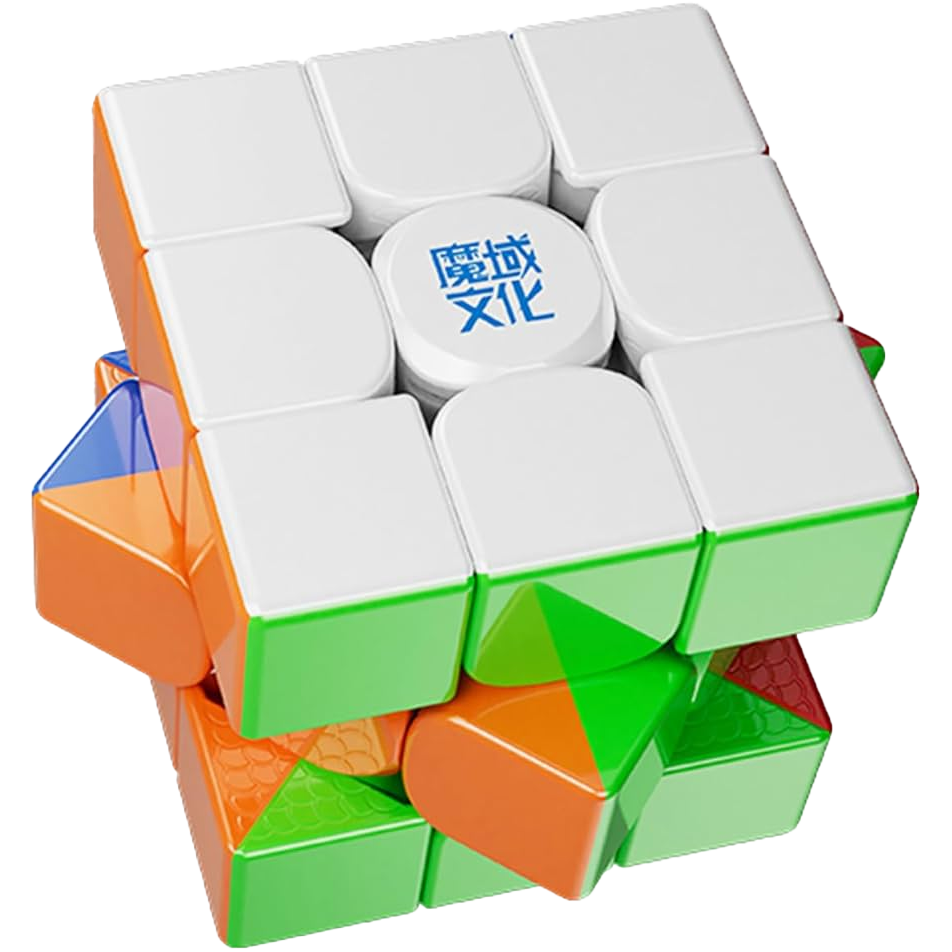 |
Moyu WRM v10 – If it isn’t broken, let’s fix it!
|
Moyu has been working hard at making very slight variations to a successful cube design and calling them with different names, instead of – say – trying to have a single cube and add customisations to it. It’s the software development equivalent of publishing pre-releases of all your apps knowing that some of the features you’re releasing are probably bunk, but some users might like them. Queue in the RS3M Super, Super 2, v5, the YS3M, The WRM v9, Super, as slight variations each on existing designs.
But while some of the piece design was slightly modified, and each version did come out with Ball-Core, Maglev or neither as options, one of the key elements to the Moyu design (and arguably one of the gems behind their success) has been a constant, reliable, trusty friend : the DAS (Dual Adjustment System) with its iconic blue ring and screw. It has been in all Moyu cubes from the budget RS3M line back when it was a budget cube to the WRM flagships back from when they were called GTS and WR meant that it didn’t have ridges.
And now for some unfathomable reason, they’ve decided to drop the working formula, play a Dayan and introduce an overly complex compression & travel-distance adjustment system that turns reliably great cubes (if sometimes an acquired taste, like the YS3M), into a mediocre product that feels like a budget knock-off until you spend sufficient hours trying to find good settings and breaking it in to make it an ok cube, instead of going head to head with GAN to aim for the “best cube available today”. Trying is good. Failing but then still releasing the failure is not. The product managers at Moyu should have had the testicular fortitude to tell to their management “we tried something new, spent several months in designing it, and the cube unfortunately feels like equine droppings”. Instead they went for “it’s a new design!” (I’ll let you fill in the relevant “employee of the month” meme speech-bubbles).
Gone are the screw and compression ring that have been as simple to adjust and swap across cubes as they were powerful and flexible. Enter a compression gear that you need a stick or screwdriver thin enough to reach down and turn (Note: the halberd-like screwdriver they give you with the cube unfortunately has some trouble to fit in between the moving elements inside the center piece. Also note : thank you for providing a screwdriver now that there’s no screws anymore…). Unfortunately the loosest settings on the gear is already uncomfortably tight for many, and making it tighter won’t help. If only there were a way to let you have a very broad range of possible tightnesses that is continuous and can be adjusted easily… oh wait, there was… and they decided to remove it.
I can understand that there probably are production and economical reasons behind it : a completely plastic core means fewer steps in the production and assembly as you don’t need to have plastic pieces and metal bars that you have to produce separately first and then screw into each other. But you better make sure that the result is worth the change, especially if you’ve been consistently producing the exact same internal pieces for the better part of 6 years now.
The result of all this search for something new is a cube that feels cheap, is too tight for comfort, locks up like crazy, and will force you to go through a ton of different settings making you hate every single minute you lose trying to clip the travel-distance gear by the correct amount of notches. If you spend enough time you’ll eventually find settings that make it not suck, turning this cube into an ok cube that still feels like cheap plastic and doesn’t feel like much of what Moyu has been releasing for the past 4 years.
In a sense, the cube feels like a direct descendant of the original WRM from 2019 : hard, somewhat hollow plastic that feels compact and hard when turning. But while the WRM19 (and GTS3M) had a fantastic turning and flexibility, making them cubes that many still main for some events even 5 years later, this one just locks up at weird times, and even when it doesn’t, it just feels like a cube from several years ago. You wouldn’t be too off the mark if you consider it as a UV version of the old Meilong : A perfectly fine cheap cube with good magnets, mostly light to turn but a bit locky. Except that the Meilong was a 5$ cube, and this one is 30-35$ if you take the Ball-Core version. (Also, a v2 of the Meilong has come out at about the same time as this one, and it leaves both its predecessor AND the v10 in the dust.)
The look is also something where Moyu has taken steps in a new direction. Let's do away with the flat bevels on the center caps that started with the WRM 21 purplev and evolved through the last several releases, and had a distinctive look that not only looked great with its purple or teal internals, but it also felt like some OTHER than all of the other cubes which were mostly parroting the blue-logoed apple-wannabe brand. The WRM v10 has decided to try and be creative, and the results basically looks identical to a GAN cube with the circular center cap and deep bevels you can find on 90% of cubes. (It should be said : the Meilong v2 has the exact same external design so it’s not something that we can throw on the v10 itself, more of a “recent developments” thing on all MOYU’s cube lines.)
So should you buy it?
I don’t think I’ll be recommending the WRM v10 to many people. There currently are at least 5 Moyu cubes that I’d suggest before this one: (in no particular order) the YS3M, the RS3M v5, the WRM Super, the WRM v9 and, seriously, the Meilong v2. All of these are excellent cubes at very different price points that all provide that slightly soft Moyu feel and have fantastic performances. This one? Not so much.
Fun fact : I’ve tried swapping the core of the WRM v9 into this one and… it’s actually not half bad! You have to replace the centre-piece casings as the groves of the v10 pieces are completely new, which means that the spring compression doesn’t work anymore (note: you can still increase the spring compression by dropping a small ring of cardboard under the maglev or spring inside the DAS ring). But you’ll be able to adjust the travel distance properly and obtain a cube that does actually perform like a flagship cube from one of the best 2 brands of the past several years. I might even prefer it to the v9 itself, which at least means that you’re not just sacrificing a v9 for the sake of making the v10 usable. You’re still buying 2 cubes to make one usable, so you might just as well pay the price of FOUR of them and get a WRM Super.
The resulting v10/9 hybrid does beat out the Meilong v2, but it does it at 8x the price. Also, it solves the core breaking that several people have experienced with the v10. Nevertheless, if you’re willing to support Moyu and have a v9 laying around that you haven’t been using, then this is not a terrible cube to have!
TLDR: A cube that locks up way more than it should and if it weren't the flagship cube from Moyu, nobody would talk about it. If you spend enough time fiddling with it, you can make it passably good.
- Weight & feel – Light weight, with solid plastic
- Turning Speed – Moderate to fast
- Corner Cutting – Serviceable, not the thing
that limits the performance of this cube
- Magnets – Medium strength, perfectly adjusted for
its speed
- Lockups – The bane of this cube on most of the
settings that are possible
- Sound – Relatively loud, with something of a resonance from the hollow plastic pieces
- Looks – Almost identical to a Gan but with a
different logo
- Plastic – Sharp, solid, and shiny enough on the
Maglev version
- Similar-feel cubes – Meilong v1, Zanchi
Pro
- Price – 30–35$
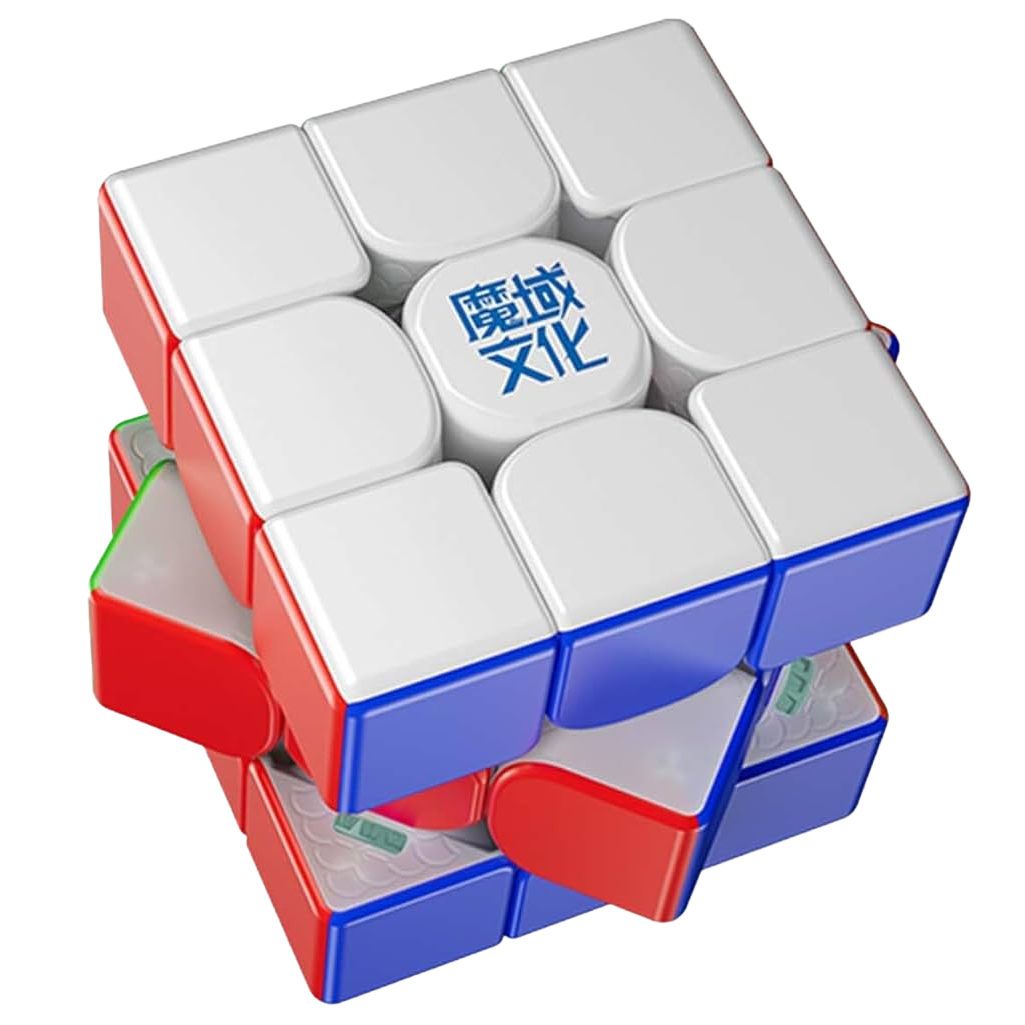 |
Moyu Super Weilong – A great gift if you don't know
much about cubing... or if you know enough about it.
|
As for how the new Moyu WRM actually is, the WRM10 (sorry “Super Weilong”) is a light cube with a mellifluous feel, adjustable magnets, fast turning, forgiving auto-align and corner cutting, and likely one of those cubes you pick up and break 2 PBs within minutes of starting to use it.
The look is similar to the newer Moyu cohorts of cubes, but with slightly more squarish center-caps, and white internals that reduce the contrast you find in the purple and teal internals of the latest Moyu cubes, making it feel less distinct and less interesting. The plastic is much more translucent and crunchy, reminiscent of the Gan11 or to some extent the WRM19 more than any of its last 10 siblings.
Of the WRM19 it also shares the hollow solidity and floatiness that made it a cult cube for many, but with the perks of the last generation of cubes : an auto-align that allows to be very fast AND avoid big screwups, very light turning, great sound (reminiscent of the WRM19), and something that will never lock up on you. The adjustable magnets – a feature which had all but disappeared from Moyu releases since more than a year ago – are a very welcome re-addition, and are calibrated in a way to let click-oriented people get something similar to the WRM9, but also those with a more reasonable relationship with friction and noise to tune it down to something less tactile. I personally would have liked an even weaker setting, and as there’s 8 different levels to choose from right now, they could easily have stretched the range a bit more on the weaker side.
In terms of the way it feels, the adjustable magnets really do make a difference. You can truly change the feel from something closer to a WRM9 or (almost on the opposite end) to a WRM19, while retaining a lot of forgiveness and a ton of speed. And this to me is a clincher : What the highest-end flagship cubes from the two major brands bring us now are cubes that have stellar performance AND adjustability to get that extra 10% fit tailored just for you.
Which means that if the clickiness of the WRM v9 feels good to you, you won’t need this cube. If you’re rocking a Maglev WRM19 and feel good about it then you likely won’t need this cube. But if you want a cube that will allow you to play around and find the perfect balance for you, then this cube goes a big step beyond what all the other Moyu releases from the past 8 months have done, which was providing a single feel with no/little adjustability. The fact that you can buy all the other Moyu releases from the past 8 months together for the same price as this one cube is something of a peculiarity in a period that seems to be transitioning once again to higher prices.
Indeed, good cubes are going back to having prices in the 30-40$ rather than 12$ range. If you take a step back and ask yourself : if the best GAN cube costs 90-100$, is it surprising that the best Moyu one costs close to that amount? The answer is likely “not so much”. But Moyu might have done a disservice to the cubing community 3 years ago when they popped out of nothing a beast of a cube for less than 10$ that outperformed the flagships from half of the cube brands that were out at the time. Now the pendulum is swinging back and what we feel right now might simply be growing pains that will go away once the big flagships start all being in the 35-45$ range again. But also, you can bet that GAN’s product managers are very happy that they can continue selling very expensive cubes now that someone else is following along.
In terms of what you do get for that price, the packaging is slick. If you receive something like this for Christmas you’ll be a happy person as you open up this thing — much to the chagrin of cube stores that now have an oversized box that costs a ton to ship, gets delayed because it’s just big enough to not fit easily in any delivery crate and generates overhead costs that then have to be put on the customers. The actual CONTENT of the box itself is less awe inspiring. Besides the cube, you get pretty much the same thing you get in an 8$ cube box, with the exception of yet another demonstration that Chinese marketing teams might not quite have the finger on the pulse of western culture.
Let me stomp through the landmine-filled topic of cultural sensitivity, and simply state that there are some thing that typically come with a cube that don’t exactly resonate with the sensitivity of people coming from a number of different cultural moulds. A shiny credit card-sized piece of plastic with the name of the cube on it, a square collectible cardboard tile with the image of a smiling well-dressed stranger, a plastic triangle whose objective is ostensibly to prop up a cube at an angle. These are all things that most people have no use for, but feel like an unfortunate marketing effort from people who don’t cube. But here is where my cultural myopia might be coming into play. I can imagine a world in which people DO collect square cardboard tiles with the faces of strangers on them, in which they DO care about having a decorated plastic card with “GAN” written on it… And maybe that world is a country that I know next to nothing about and has 1.4 billion people. If that’s the case, then good for you cube manufacturers marketing teams, I hope that there’s some returns on those investments.
But for the life of me, I’ll not imagine that a bloody bracelet to carry the cube as a watch will ever be something that anyone with a modicum of self-awareness would want to be found dead wearing. The RS3M v5 robot was cute and of little use, this thing isn’t even cute. And if this is what you decided to put in the box to appease people who wouldn’t like a 200% hike in cube prices, then you should reconsider what your interns are making you drink during those brainstorming sessions.
All in all, these are considerations that are somewhat unrelated to the cube and its performance. This is a fantastic cube that adds back some of the customisability that was par for the course until 2 years ago and had started to disappear of late from all but the most expensive cubes, and brings a great level of excellence on a very light and fast puzzle.
But Bas, should I buy it?
This is an expensive cube, but it’s not more expensive than the flagships of the other big brand. The packaging and frills make it a great gift for a niece or godson or close friend old enough to care about a quality package and not into cubing enough to know that there is a marginally different cube from the same brand for 1/5th the price. The frills and shining package do have value that goes beyond that of the cube itself, so if the person you’re giving this to (or yourself if you happen to be something of a collector) does appreciate the value, then this is a fantastic product to buy.
If you only care about performance then this is ALSO a fantastic product to buy.
If you are somewhat attentive to your economies, then this is not a sufficient step up from any of the 15-25$ Moyu alternatives that have come out in the past 4 months.
TLDR: Experienced cubers will like its customizability, newcomers will like the high-quality box; neither will like its price.
- Weight & feel – Light, pieces feel solid and buttery
- Turning Speed – Very fast and yet very forgiving
- Corner Cutting – Stellar
- Magnets – Adjustable, from average strength to quite
clicky
- Lockups – Nope!
- Sound – Far from quiet but with a low pitch that makes it less annoying than many other cubes
- Looks – White internals make it look very bright,
slightly more squarish caps look great
- Plastic – Solid but hollow, a bit crunchy and very
shiny
- Similar-feel cubes – WRM v9, WRM19
- Price – 80$, slightly less for the tuned-down
versions
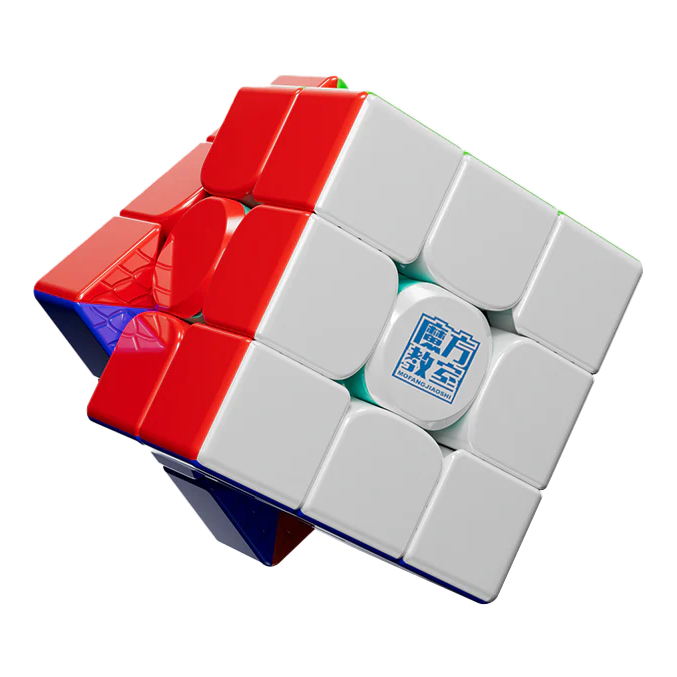 |
Moyu RS3M v5 – The box may be goofy, the cube is
anything but!
|
So while everyone is waiting for the next Moyu product to arrive, let’s review one of the latest almost-the-same-but-not-quite releases from an increasingly multi-pronged series of cubes known as the RS3M. The RS3M v5 is the third cube in the budget line of cubes that shocked the cubing world and has now become the most owned speedcube in the world. And if you’re wondering why it’s not called v3, well… probably letting a LLM come up with a name might yield better results: the second one wasn’t called v2 either, and even if the “RS3M Super” line has branched out into the “it cost HOW MUCH…?” realm, there’s still 5 of them. Unless we count the 3 versions that were released before the MF3RS3M2020 came out.
And so here we are with 3 new versions of a cube from a brand that has released 12 cubes in a span of months, and this time, it comes with a fancy cube case! I’ll give mad props to the marketing team for coming up with a better alternative to the triangular cube stands that everyone is trying to spoon feed us at every purchase. And truth be said, the “Cube Robot” is actually cute... and will end up in exactly the same drawer as all the other cube boxes, until we remember to clean up and its life cycle will go from inside a box, to inside a drawer, to inside a furnace with around 1h of life in the light in between all of that. Who said robots don't get any love!
But as for the cube itself… I guess the 12th time is the charm. This is a cube that works really well, is super fast, super light to turn, but very controllable and very forgiving. This is what you want from a cube, and if we had to go through a WRM v9, Super2 and YS3M to get there, then it was well worth the trip. The cube has the very appreciable advantage of retaining the price level of its early predecessors, making it an excellent candidate for first cube, and for second one, and probably third too. The solving is very pleasant, without the jarring clicks of the WRM v9, or the stiffness (before you un-tighten it) of the ys3m. The turning feels similar to the airy control of the Meilong M, but with the corner-cutting and forgiving smoothness of the first RS3M. From its predecessor it also retains a flagship-level quality of build (from the plastic feel to the caps design), but without the clackiness and loudness.
It has become an insta-main for a lot of Roux and OH solvers thanks to the combination of lightness and smoothness, and it is forgiving to beginners, making it a cube that people should seriously consider as a gift to novices. The standard versions are just as good as the ball-core one (you forego the auto-align for a slightly lower price), as long as you wear off the frosted surface — which at the end of 2023 is finally starting to feel like most of the ideas we tend have when a bit more than tipsy. The UV version is fantastic if you can pitch in the necessary budget, but even if you can’t, this is a cube that belongs easily in everyone’s cubing bag.
But Bas, which Moyu cube should I get?
Going for bangs for your bucks, the RS3M v5 is hard to beat. I find myself using a loosened YS3M more than this one, but that one is finicky and might not be the best for new cubers. Get the UV Ball-Core version to get the best version, or anything else to align with your budget, you won’t be disappointed. For the higher-priced cubes (super2, wrm9, and maybe the upcoming wrm10?) the nuances of the cubes are going to hit the spot differently for different people and their popularity will wane with time, but I suspect that the RS3M v5 will remain a big favorite for quite a while to come!
TLDR: The RS3M is back with the right features, the right performance and the right pricetag
- Weight & feel – Average weight, pieces feel solid and buttery
- Turning Speed – Fast but forgiving
- Corner Cutting – Stellar
- Magnets – Average strength, clickier on the
Ball-Core version
- Lockups – It can hard-lock if you try to cornercut
too much, but won't ever do it mid-solve
- Sound – Far from quiet but with a low pitch that makes it far less of a nuisance than its predecessors
- Looks – Sporting the modern round-ish but sharp look
of the latest generation of Moyu cubes.
- Plastic – Solid, blocky, and when the frosting
finally wears off, very nice
- Similar-feel cubes – RS3M 2020, YS3M (but less stiff)
- Price – 8–20$ depending on version
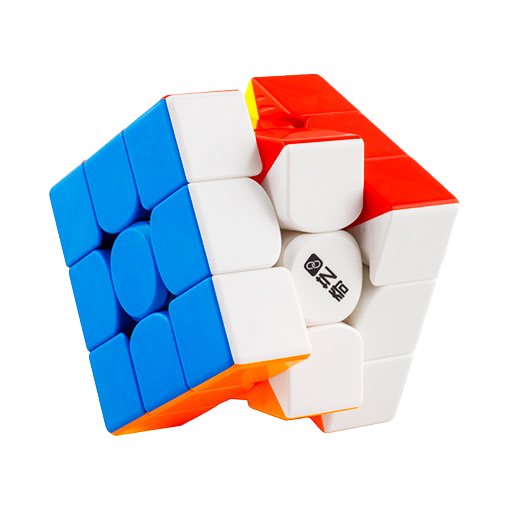 |
QiYi SC-S – Finally a true "budget" smart cube?
|
The QY SC-S (known in stores as QiYi Ai, for some reasons), is likely my favorite smart cube that costs less than 100$. Calling it budget at its ~15$ price tag would not be faire compared to normal speed-cubes, but compared to all the other smart-cubes in a similar price range it has a couple of big advantages.
1) It doesn’t suck.
Most smart cubes tend to be locky, bulky, slightly janky cubes, that are mostly ok if you evaluate them as SMART-cubes, but not if you were to apply the same criteria you’d use for a SPEED-cube. There’s a couple of exceptions (the “works half the time” Moyu AI, and the “wallet-blasting” Gan 12 Ui come to mind), but usually if you pick up a smart cube you’re not expecting to get your usual averages since they might be good, but they aren’t speed-cube good. The SC-S is a speed cube. Mind you, not a top-of-the-line speedcube (this is no 12ui), but it’s a very solid speed cube with good turning and control, decent customisation (more on this later) and overall feel of a speedcube you might want to pay 15$ for. It’s not as light to turn and as forgiving as the QiYi M Pro, but it feels pretty dang close.
2) The software doesn’t suck
This is probably the part I’m most positively surprised by : imagine a cubing app that doesn’t want to look like the user interface of a mmorpg (thank you Gan Cube Station), nor a kiddies iPad app (you’re welcome, Rubik’s connected), or a colourful punch in the eyes that only works if you can manage to understand how to log in (oh… Moyu… you rascal).
This app is rather minimalistic, very easy to register and log into, Has clear sections dedicated to the things you want to do with a smartcube most of the time (which is, for the vast majority of people, to just time yourself and sometimes compete), a nice stats page that is not too noisy and loaded with visual stuff, and without requiring you to have a top of the line smartphone to run a glorified timer without lagging.
Imagine my surprise when the thing is also able to analyse roux solves.
And yes, the stats charts could be better, the “estimated ranks” could cover geographies outside of China, and it would be great if the Roux analysis went a bit deeper than a single split of 4 steps, but if I’m complaining about this it means that the giant list of typical complaints one has for smart cube apps are simply not relevant here!
With that said, there are a couple of drawbacks:
The firmware / API are closed and difficult to reverse-engineer, which means that you won’t be able to use this cube with your favorite cubing apps. This might be solved with time, but for now we’re stuck on their system.
[UPDATE!] The brilliant mind of Flying-Toast (u/This_Hippo on reddit) has been able to reverse-engineer the protocol, so now support for it has been / is being added to all your favorite timers!
The batteries are non-rechargeable. That’s not a deal breaker nowadays, with likely hundreds of hours of cubing before I’ll need to swap batteries, but if you’re planning on using this for 5 hours every day then that might be a turn-off.
The customisation is ok but not stellar : no way to adjust travel distance, so you’re stuck with changing the spring compression, which is ok, but it really limits the range of possible feels you can achieve. The factory settings are a bit stiff, but at least they have borrowed the spring compression ring with coloured dots from the Tornado v3, so you can actually SEE what settings you’re at and can easily loosen it a bit.
Magnets are perfectly fine, plastic feels ok and it’s blessedly NOT frosted, and overall if I had gotten this as a speedcube I’d have said “eh, it’s ok”, but might have suggested something different for the same price. Except it’s a smart cube, and if I compare it to the Gan I carry (S), or the Moyu AI, this is simply a better cube for 1/3 less money.
So… should you buy it?
If you don’t have a smart cube I’d say absolutely. If you DO have a smart cube and it’s a Gan 12 Ui (fp), then why are you even here? If you do have a smart cube but it’s another one, then… it really depends on how much you use your smart cube. If you use it on a daily/weekly basis for comps or training, then this is probably a great update that will cost you half of what you paid for your current cube.
TLDR: The best budget smart cube available, and the software is actually good!
- Weight & feel – Average weight (83g), solid
- Turning Speed – Moderate to fast and smooth
- Corner Cutting – Perfectly workable, can
adjust spring stiffness to improve
- Magnets – No auto-align, but medium strength that
balances well to avoid overshoots
- Lockups – Sometimes : the cube is relatively tight
and the travel distance can’t be adjusted
- Sound – Reasonably quiet
- Looks – Without the logo it would be virtually
indistinguishable from the QiYi M Pro, with the beveled center
caps and rounding of the edges inner side. The logo is very
meh.
- Plastic – Solid and stiff, glossy and perfectly fine
- Similar-feel cubes – QiYi M Pro, Moretry Tianma
- Price – 20$
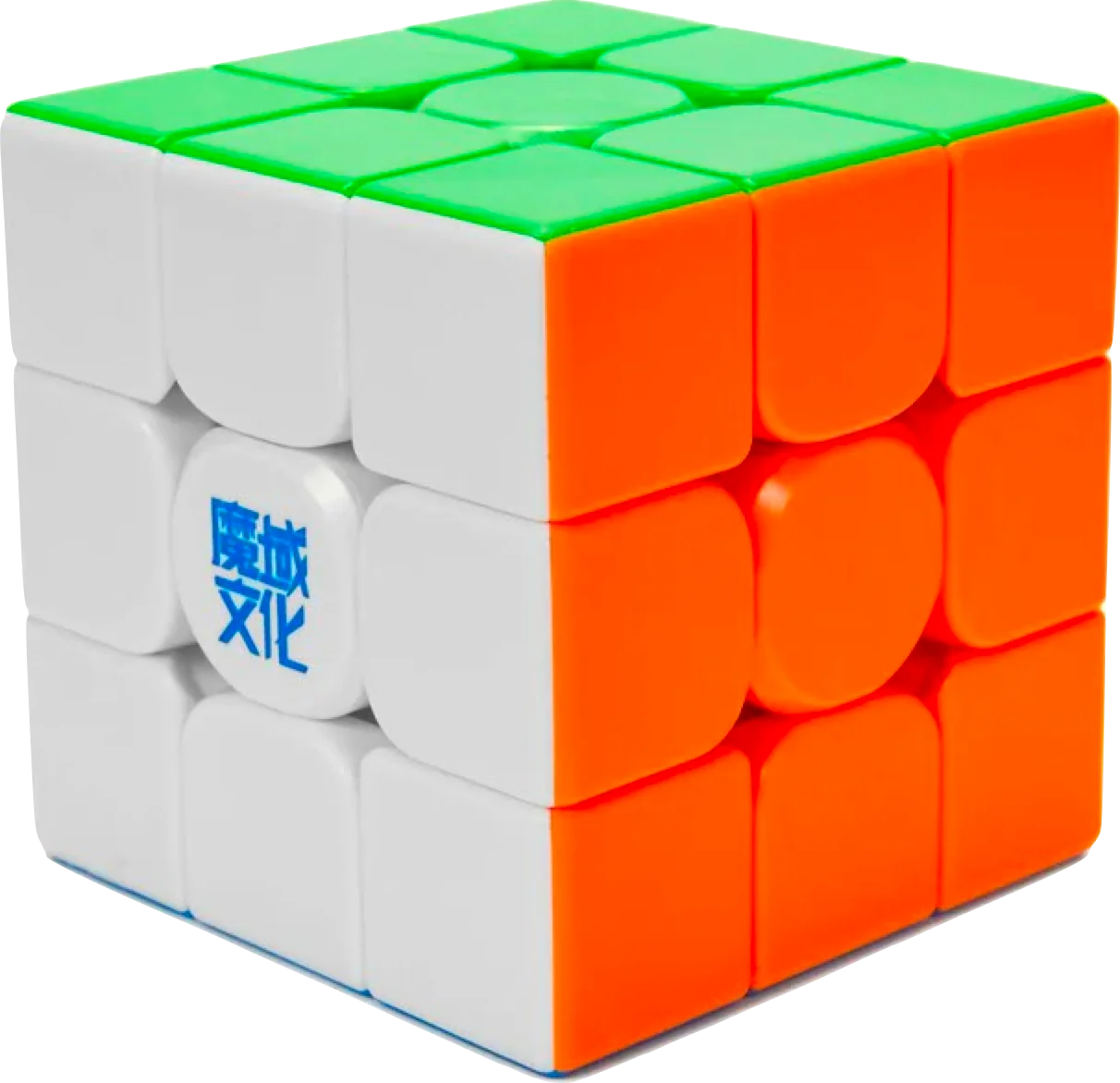 |
Moyu AI – The best smartcube you don't have to
mortgage your house for!
|
But now Moyu has come out with a new and revamped version that solves the technical issues of its predecessor while bringing some new features on the table. The 1 year of battery life is the first one, which is a big step up from its forebear, and means you’ll just forget about battery life until — many months down the line — you realise you need to replace two small button batteries (which take about 45 seconds and a small screwdriver to do). The design & logo have been updated to the look and feel of the newer moyu releases, making it look pretty good and modern. Its name might be the only gripe I have with it : in an age where everyone and their uncle are calling things by over-hyped names, calling a sensor-based measurement of how a piece of coloured plastic turns “artificial intelligence” might be stretching the concept a bit too much even for Moyu.
In terms of performance as a cube, though, this is a solid speed cube, with a feel not unlike the WRM v9, if a bit stiffer and less clicky, and at 56mm rather than 55mm. The lack of corner-core magnets means no auto-align, but that is hardly an issue : the standard magnets are well calibrated and the overall solving is pretty good. I was able to push out several almost-pb solves within one hour of solving, which is pretty good for any speed cube, let alone a smart-cube. There are no options for spring compression or travel distance, but at under 30$ for a smart-cube, it’s a very honest trade-off. The pieces sound a bit hollow, which makes it feel different from other Moyus, but sound is rarely the reason why you choose a cube (despite what your flatmates or parents might prefer), and this one is not noisy by any stretch of the imagination. There is no UV version of it, so you'll have to wear it off a bit before you can avoid any embarrassing yeets during your most enthusiastic solves.
The only true drawback is something that will be resolved with time : The cube is a bit too new for the usual smart cube platforms to have updated their drivers, so you’ll be stuck using the official Moyu WCU app until that happens. Say what you want about Moyu engineers, it would be better if they stuck to doing hardware... The app has a number of issues, most notably the English version not actually being in English (only few texts have been translated and the majority of the important ones are still in Chinese, making it difficult, for example, to create and activate an account). These are obviously temporary issues, and by the time you’re reading this they might have been solved. What’s more, once properly connected, the app works pretty well, even if most of the texts remain obscure. If that is not the case, hey, it's always a good time to learn a bit of a new language!
All in all this is likely the best entry-level smart cube you can get today, superior to the other smart-cubes in the price range (notably the lower-budget Gans). If you don’t mind spending a small fortune and want the best smart-cube the market has to offer, then I’ll still recommend the Gan12ui Freeplay, but if you want the best smart cube at a price lower than many speed cubes, it will be difficult to do better than the Moyu AI.
TLDR: The best budget smart cube available, even if the software still suck
- Weight & feel – Average weight, with slightly hollow pieces
- Turning Speed – Moderate to fast and smooth
- Corner Cutting – Perfectly workable,
unfortunately cannot be adjusted through springs
- Magnets – No auto-align, but medium strength that
balances well to avoid overshoots
- Lockups – There might be some for people a bit more
forceful in their turning, but pretty rare
- Sound – Rather quiet compared to recent Moyus, not as quiet as older cubes
- Looks – Follows the look of the new generation of
Moyu cubes, with the new logo and center cap design making it
look pretty modern and sharp
- Plastic – Solid if slightly hollow, unfortunately not
UV
- Similar-feel cubes – WRM v9 (but less clicky), WRM20
- Price – 27$
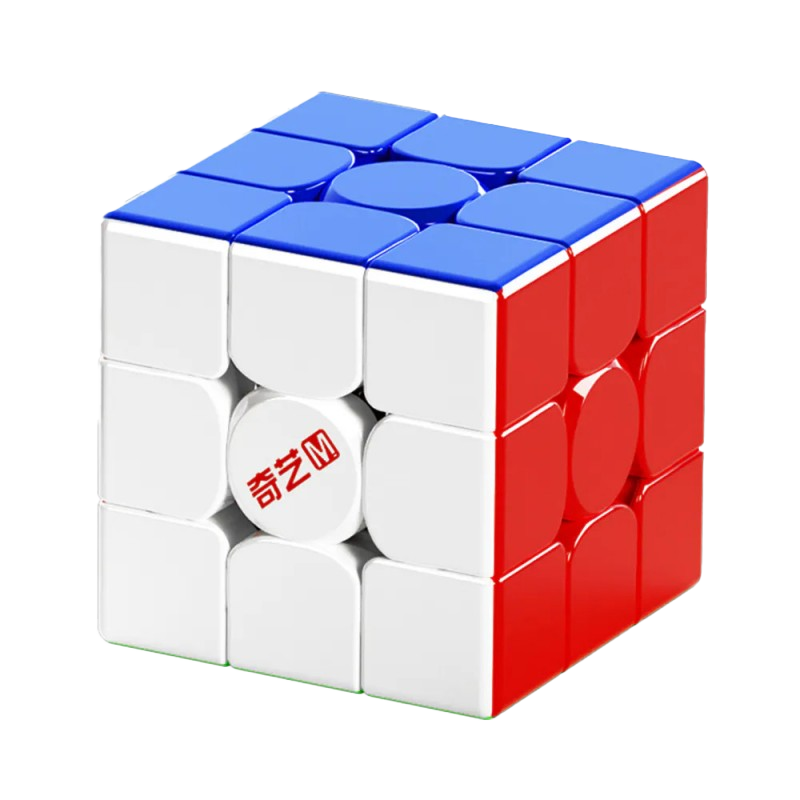 |
QiYi M Pro – The new best cube under 10$?
|
The QiYi M Pro is one of the best budget cubes to hit the market since Moyu released the RS3M back in 2020, and even they realised it was a bit too excellent for its own good, and have incrementally increased its price to ludicrous heights (depending on how you decide to consider subsequent releases of a cube that has had as many labels as the contents of my grandpa’s liquor cabinet).
The MPro comes in two versions, a standard springed version that sports a frosted surface and a “more expensive” maglev one that comes with shiny plastic. The quotes come from the fact that while other cubes have been tacking on 30% more on the price for swapping a spring with two magnets, the Improlev costs only 10% more than its sprung version, on a cube that costs less than $10. Not that the difference is really big besides the choice of plastic finish (which, unless you’re an irredeemable monster, should be an obvious one).
The cube is solid, controllable, comes slightly tight out of the box, but has a whopping 11-setting spring compression adjustment that actually lets you go from too loose for most people’s taste to slightly too tight, and really lets you find the right setting for you. Contrast this with the 10-step Tengyun V2 compression settings that went from springy to still springy and you see that SOME people have learned how to calibrate the range of their adjustment settings. The fact that you don’t need any tools to adjust it either is also a nice plus. It also means that the range of adjustments make the difference between spring and maglev rather moot, as it is possible to get almost identical feels by just finding the appropriate compression for each system.
If there is a gripe I have, it is that in its factory defaults, the cube locks up and is slower than it should be. This is easily fixed by loosening the screws a tiny bit (I did mine -1/4 turn) and re-adjusting spring compression (I put mine at 3 out of 11). But it means that people who land on this one as their first cube might not have the knowledge or patience to tinker with the settings, and might end up with a cube that is not as good as this thing can actually be and not know what they’re missing.
But once you do find the right spot of “looser settings that avoid loss of cube shape”, you get a puzzle that is fast while still feeling compact and controllable. It is also a bit clacky, (but so was the RS3M, and this one doesn’t require lube to avoid spring noises), and has a hollow-plastic feeling that is reminiscent of the Tianma, but without being so loud that your neighbours will knock at your door to tell you to stop throwing legos at their wall.
Magnets are very well calibrated for the speed of the cube, clearly clicky, but not too strong, and while it lacks a ball-core-driven-auto-align, it does what it is supposed to do perfectly well. What that means, however, is that if you’ve gotten used to not finishing your turns, you’ll end up having to abuse the corner-cutting, which is about as good as you can expect from an $8 cube. I’ve found some of my solves screwed up by incomplete turns that lock up, but I’ve been able to adjust easily to a more accurate turning without any loss of speed (at least at my level).
Slices work very well, the Maglev version has a floaty feeling that is reminiscent of the Tengyun (the 1st one… the good one), and for roux solves that works pretty well. Unfortunately the less-than-stellar corner cutting means that my One-Handed solves get screwed half of the time when I get to LSE as I am utterly unable to combine MU turns without locking up. This might be something that doesn’t work for everyone.
Overall, this is a cube that is so inexpensive I don’t mind having on me all the time and clearly good enough to get good times (and a failed PB3 on my first AO50). I’d definitely advise anyone to add it to your next cubing shopping cart, or consider it if you’re getting a new cube and don’t know what to get. I actually like the feel of the spring version better, it feels a bit less clacky and a bit more smooth (probably due to that tiny bit more stiffness from the spring that feels better at lower tensions), but the frosted surface is a deal breaker for me. If you’re deep into ASMR or have other fetishes that make you like terrible things – or if you want to save the price of a hot dog at IKEA – then the standard might be a better version for you than the maglev.
TLDR: Probably the new king of the budget cubes; for its price there’s no reason you shouldn’t have one somewhere around.
- Weight & feel – Average weight, with solid plastic
- Turning Speed – Moderate to fast
- Corner Cutting – Bad for today’s standard,
especially without auto-align from ball-core, but serviceable,
especially at this price
- Magnets – Medium strength, perfectly adjusted for
its speed
- Lockups – Likely when on the tighter settings, and
can still happen if you try to rely on corner-cutting too much
- Sound – Moderately loud, with something of a resonance from the hollow plastic pieces
- Looks – Sharp, but rather indistinctive
- Plastic – Sharp, solid, and shiny enough on the
Maglev version
- Similar-feel cubes – Moretry Tianma, Tengyun 1
- Price – 8-9$
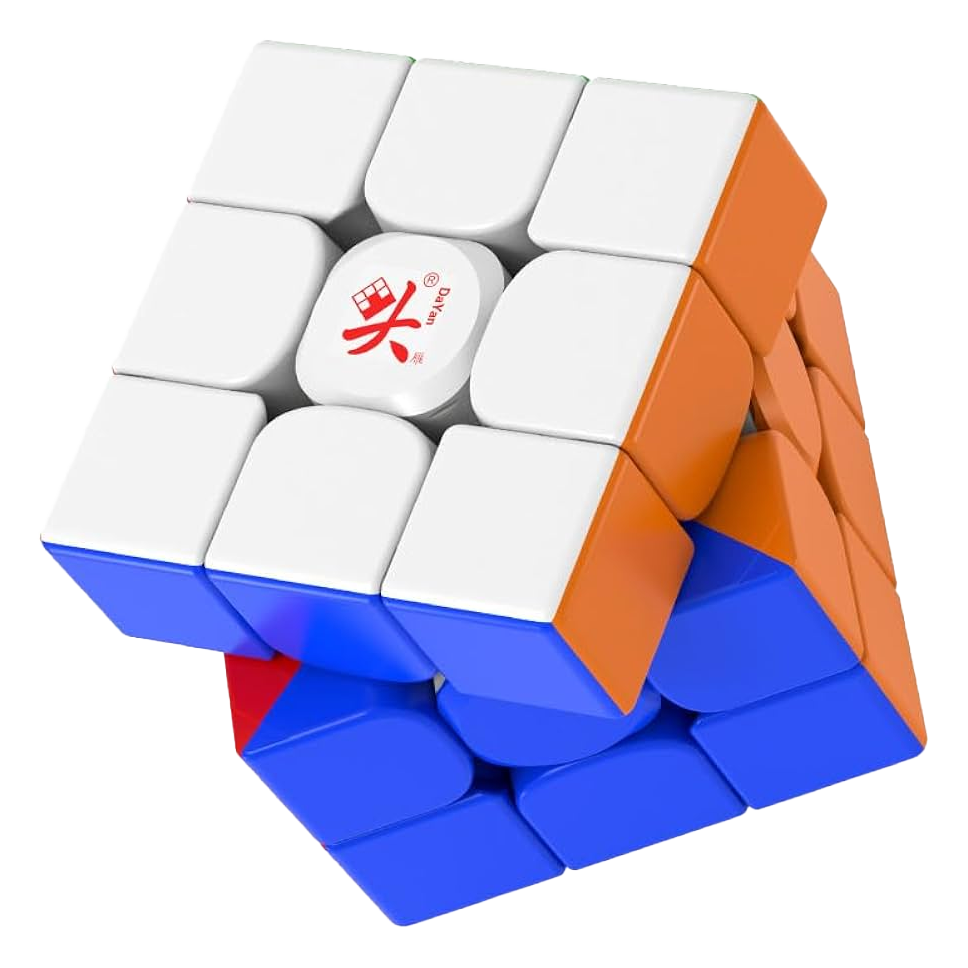 |
Dayan Guhong Pro – The best Dayan cube since the
Zhanchi Pro… but that’s not saying much…
|
Now a new cube has come, that rounded some of the rough edges of its predecessor, blended the names of the Guhong and the Zhanchi Pro, and at under 20$ is a good contender for mid-range cubes. Until, that is, we take into account the fatal flaws in its design that make it break too easily for comfort. This time at least, it doesn’t seem like it will get destroyed by just solving it. Instead, the design of its spring compression is such that if you turn the wrong way you risk breaking the center piece and making your cube unusable. The cube manual stresses in red text that the piece cannot be turned clockwise, hoping that the average cuber born after 2008 has seen enough clocks tho know what direction that is (hint: it’s the one without the ‘ in cube notation).
But let’s pretend that no-one will render their cube useless with 1 literal wrong turn after 10 minutes of taking it out of the box. Let’s also forget that the centre caps pop off regularly when solving (this has been reported only on the 56mm and 55mm versions of the cube so far *UPDATE, actually happens on the 54mm too T_T*), the cube itself, depending on setup, feels way-too-much to quite fast, and is about as forgiving as your loving wife when you make the error of mentioning your past dalliances. The magnets feel fine and the auto-align picks up relatively early but sometimes lets you overshoot to the point that you lock up, corner-cutting when you’re using a reasonable compression (4-5) is shoddy at best. If you’re an accurate and fast cuber this might actually work really well for you, but most people will either be turned off from it, or in the case of new cubers, will love the speed but not understand why their times are so bad on this cube.
On the topic of novices: it has by now become a meme that Dayan likes to put a ridiculous amount of lube in its cubes, but whilst usually funny, here it is detrimental to the experience that new cubers will have with this cube. Out of the box it comes with the loosest spring compression (more on this later), literally sweating lube and utterly impossible to control. If you’re a parent gifting this to your child their first reaction will be “what the heck have I got spreading on my hands” and the second will be “how do I control this thing?”. For the sake of all those murdered baby silicons, Dayan, learn half measures.
And speaking of half measures, whilst the latest cube to come out of the Dayan engineering shack had multiple nuts and bolts that needed to be swapped individually by hand to change travel distance (rather than, say, using a screw, or an adjustable position), the Guhong Pro simply doesn’t let you change it. In the vein of the MGC EVO, you only get to change spring compression, which the English version of the manual tries and fails to convince us is “center distance”. It isn’t: it’s a spring compression wheel that works like every other compression wheel since people started putting them into cubes. If you’re wondering why it’s bad to only be able to change springs compression and not travel distance, it’s like having a car that can only turns left; it can work if you are a Nascar racer, but it might be a problem in most other circumstances. Having the possibility of tightening the screws slightly would make the first 2 compression settings (out of 5) actually meaningful, instead of something that you need to advise anyone to change as soon as possible.
The look and plastic is pretty ok. Fortunately between when they developed their marketing campaign (sporting a “Matte Appearance: Excellent tactile feel with no scratches!” tagline) and when the cube actually came out, somebody had a moment of lucidity and decided to switch to shiny plastic, which grips perfectly well (even though the build quality is meh at best, with moulding seams, uneven bumps etc make the specular reflections look less than great). The feel overall, however is not of cheap plastic, and the cube sits solidly in the hand. Once you’ve wiped off all the excess lube and washed your hands multiple times, that is.
Now, after having poured incendiary gel on the poor souls of the Dayan workshop for the better part of 6 paragraphs, I have to give a honest and deserved tip of my hat to the product managers who decided to adopt the “multiple versions of the same cube” concept in the smartest way I have seen so far. Instead of giving you progressively more stripped down versions of your cube, they actually propose variations that are meaningful : Big, Medium, Small cubes that let you choose the one that fits your hands the best. The difference between 54mm and 56mm is pretty relevant, and lets you account for the important differences in hand size between people, especially the younger cubs and the older geese among us. Letting us pick one that works for us is pretty damn smart. Moyu and XMD, take notes and learn when it’s worth learning.
(Note, I’m not as partial to the choice of maglev vs springs, as they tend to not make a lot of difference, and as I only have the maglev version I cannot pretend I know exactly the effect on the cube, but I suspect that the springed version would be better.)
Overall, this is a cube where even after several hundreds of solves I am still averaging more than 1 sec slower than my typical average, and this both in CFOP and Roux. I’m not the target audience though (I’m neither a quick nor an accurate turner), but in every single solve I find myself getting small lockups or loss of cube-shape that make me lose that bit of time.
Should I buy?
If you like Dayan cubes and you are accurate enough, this might be the best one to come out since the Zhanchi pro and its very broad range of good settings allowed to cover a wide spectrum of cubing styles. But the center caps pops, the risk of breaking this thing with a single wrong turn, the lack of customisation and the overall instability makes me recommend this only to dedicated collectors. (And if you want to support Dayan, get a Tengyun v1 or a Zanchi Pro, in that order.). But with all of that said, if you have or receive one, you'll realise it's not a bad cube: it's fast, and if you are attentive it lets you get fast results.
TLDR: It's a cube for accurate cubers who want something very fast and mired by construction issues reminiscent of its predecessor
- Weight & feel – Light but solid
- Turning Speed – Way too fast on most spring
compressions
- Corner Cutting – Not great when tightened
down, better when loose (but then the issues are elsewhere)
- Magnets – Medium-strong, the clicks are clearly felt
- Lockups – A lot, or loss of cube-shape, expect to
have mis-turns and locks regularly unless you’re pretty
accurate
- Sound – Quite silent as most Dayan tend to be
- Looks – Softer than the Guhong v4, modern, likely the
best looking Dayan cube to date
- Plastic – Shiny and solid
- Similar-feel cubes – Guhong v4
- Price – 15-18$
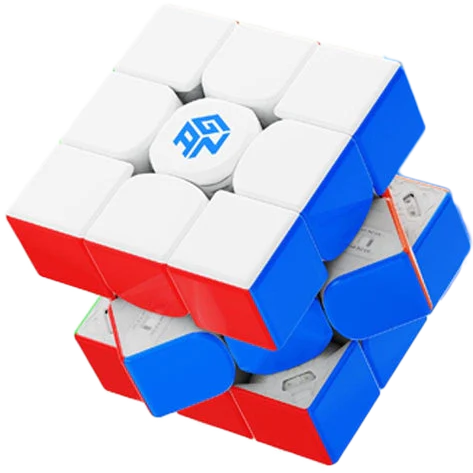 |
Gan 14 – It’s… like the 13 but better?
|
Contrast this with the kings of derping Dayan, where only God and her mistress know whether the next cube to come about will be a terrible one, a disastrous one, or a cult cube that will be relevant 5 years after its release. Or with Moyu, who create multiple lines of their cubes, then mix them up at every second release. Gan seems to know what they are doing, and the main mantra is “don’t rock the boat”.
And this boat is not rocking. The Gan 14 is a slightly improved version of the Gan13 that brings back some of the lightness and crunchiness of the Gan12 but with the non-squishy plastic of the Gan13 and with an auto-align more similar to the 12th than the 13th iteration of the cube (not that they ever actually only did 14 versions of this cube, oh no they clearly didn’t).
The magnet adjustment is also taken from the Gan13 with 6 different magnet strength rather than the 3 steps from the 12, plus a switch for the repelling edge magnets (who help out the auto-align), these allow it to go from a very light magnetic pull that keeps the cube together to a strong and very clicky Gan-style magnet feel. The range is great as it can truly match the preference of different people. Good on you, Gan, for making a cube that can have different feels and settings all in one model, rather than coming out with 3 different versions of a single cube (or 9 in the case of Moyu).
The tensioning adjustments are also very broad in range, with a travel distance that goes from uncomfortably tight to very loose, to the point that lockups become almost inevitable. Same for spring compression that go from “stiff face hovering in the air” to mushy. That’s a good sign, as it means that the range of possible configurations will let you find a balance that is right for you.
The plastic is the newer, thicker plastic that GAN has introduced in the Gan13 and used on the Gan12ui/fp. I like it, but some might prefer the ultra-light and gossamer-like plastic of the 12. It’s also stiffer: if you squeeze it, it makes no noise (in contrast to the 12). The UV treatment is wonderful as it means you can actually use the cube out of the box, although I suspect that it makes the caps so bloody hard to take off the first couple of times.
The performance is… great. I’ve been hitting my best times quickly with this once I found a setup that worked for me, which did take a bit of fiddling and testing and failing and trying again. (For what it’s worth, I keep my Travel distance at a looseish 4 and springs at a stiff 5, corner magnets at a 6 and edges on the lowest notch). However, this is not a forgiving cube by any stretch of the imagination. If the Tornado V3 lets you get away with almost anything, this cube will teach you how to turn properly by trial and a lot of error. The fact that it can corner-cut at 60% doesn’t mean that it will not punish you brutally if you screw up in-solve. If you or your kid are just starting out you might want to stay away from this cube. But then again if you’re just starting out you shouldn’t spend 80$ on a cube.
But Bas, should I buy?
If you’re new to cubing… no, don’t go for Gan cubes : they’re far less forgiving and more fragile than other brands. Go get a Tornado3 or Moyu YS3M / WRM9.
If you already have the Gan12 or 13, then this might be a gradual improvement but no radical change
If you have a Gan11, this will be a very nice improvement and is likely worth the investment
If you’ve never had a Gan, then starting with this is a great idea
TLDR: An incremental upgrade to one of the best cubes available, keeps it at the front of cube performance. But if you're looking for something different from Gan, this isn't it.
- Weight & feel – Average weight, with
solid pieces that don't creak
- Turning Speed – Very fast to moderately fast
- Corner Cutting – Ridiculously good when
loose, perfectly good when tightened down
- Magnets – From weak to very strong, with a really
good range of settings
- Lockups – Very likely when on the looser end of
travel distance, they disappear as soon as you tighten it by
two clicks.
- Sound – LOUD! The crunchines of the 12 is back, if a little bit reduced.
- Looks – Functionally indistinguishable from the 13,
the only reason you can distinguish it from the 12 is that it
doesnt have transparent plastic
- Plastic –Sharp, solid, UV glossy
- Similar-feel cubes – Gan 12, Gan13
- Price – 75-85$
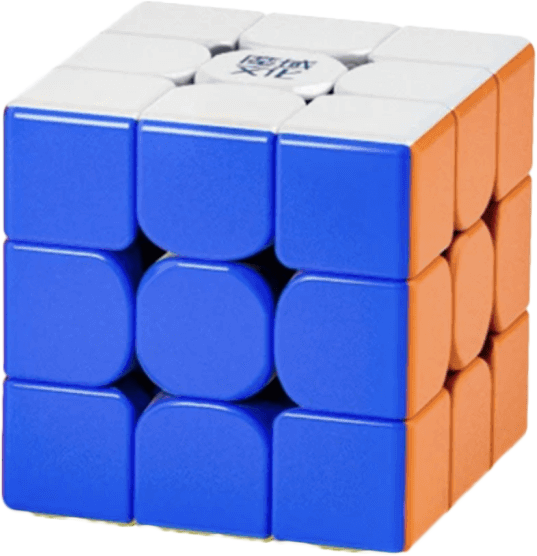 |
MOYU Weilong WRM V9 – The WRM19 is back, not quite as
good as its older brother, but louder and more
boisterous
|
The WRM 2023 (as we should rightly call it) is the newest iteration of a long series of cubes that went from the GTS all the way to the Purplev and this newest cube. These have historically been Moyu’s flagship cubes and have been the major contenders for “best cube around” almost constantly since the first GTS. In the midst of that, they released what many consider the best cube ever made, the Weilong Without Ridges, as if they were asking forgiveness for putting ridges on the GTS3 (a grippy gimmick which I and many others actually liked quite a bit). More commonly known as the WRM 2019 by modern audiences, it was a cube that brought all the things one expects in a modern cube (stellar corner cutting, incredibly smooth turning) in 55mm of solid bulk that was not as fast as the Tengy1 (another timeless piece of art) but was far more controllable and forgiving to bad turning.
But while you might be forgiven for thinking that I am sacrificing too many baby electrons to the altar of history, the reason for this temporal excursion is that the WRM v9 really takes up where the WRM 19 left off and tries to add some new things. Gone is the mushy softness of the WRM20/21, gone is the almost uncontrollable speed of the WRM21purplev, this is a newer version of the WRM19 with the strongest and clickiest magnets Moyu has ever put on a cube (including the “strong magnets” version of the GTS3M), and all the modern trappings of cube internals.
The result is a cube that feels as solid as the WRM19 in the hand, sounds a bit softer and deeper, is less elastic and mushy than the WRM20/21, and performs surprisingly well.
The cube comes in the 3 versions that Moyu has been providing us for the past several iterations of its cubes: “normal”, “a bit stripped down” and “all stripped down”. The normal version has a very strong magnetic click that is too much for what I expect from a Moyu cube, but I can imagine this being an added value for people who have eschewed Moyu until now because of it’s wimpy magnets. I find myself liking the Standard version (“all stripped down”) the most, and were it not for the frosted surface I would advise everyone to simply ignore all the other versions. But you can also purchase the 3x more expensive ball core version and simply remove the ball-core and you’ll have a less-clicky and more traditionally Moyu cube that is going to serve you very well. If you keep the ball-core with all its frills you’ll have something that goes in the direction of the MoreTry Tianma X3, which has some of the clickiest magnets since manufacturers started putting them in for us.
Corner cutting is not as snappy and fluid as the WRM19, but you don’t need it on the BallCore version: the auto-align will make sure you don’t lock up, ever. On the Standard this becomes a bit more relevant, but with a reasonable accuracy you should never encounter any issues. And the standard provides a very light magnetic pull that is exceedingly nice on Roux, while the ball-core version is annoyingly stiff on slices. The fact that you can get the WRM2023 Standard for the same price as the original RS3M on several stores is also somewhat magical.
With that said, be careful : the v9 Standard is not a forgiving cube, the absence of core magnets means that the cube overall doesn’t always hold shape if you’re turning too aggressively and you’ll end up screwing up your solves because of bad executions that move things that shouldn’t move. You don’t get any of that with the BallCore version, so it might be a much better suited cube for novices and brutal beasts… sorry, “younger cubers”.
Tensioning uses the standard Moyu dual adjustment system, which works just as well as always, but be careful with the tensioning out of the box, it tends to vary a lot from version to version, but might be too loose to the point that you get lockups on the Standard (less so on the ball core version), I ended up doing a full turn to tighten the screws to my satisfaction.
The looks are good, but not as great as the Purplev or the new RS3M Super v2 : the internals are coloured but only on the center pieces and inner stems, the inner part of edges and corners retain their normal colors, and on the Standard version they are a standard primary white that looks meh at best.
So what should you choose if you want to go Moyu, given the smorgasbord of versions and models that are currently available?
If you prefer weaker magnets : v9 Standard, but you’re probably better off with a maglev version of the original WRM19.
If you prefer stronger magnets : WRM v9 Ball-Core
If you want something in the middle : YS3M or Super2, both in Ball-Core versions
TLDR: A true “new version” of the WRM2019, with much stronger magnets, unless you get the stripped down version.
- Weight & feel – Average weight, with
solid pieces
- Turning Speed – Moderate to fast and smooth
- Corner Cutting – Passable on the Standard,
Irrelevant on the Ball-core thanks to its auto-align
- Magnets – Quite strong and very clicky on the
Ball-Core version, much less so on the Standard
- Lockups – None unless you loosen its tension, or if
you keep the stock tension (which might be loose out of the
box)
- Sound – Not that quiet anymore (previous WRMs were less noisy) but still nowhere near Gan level
- Looks – Rounded and bevelled center caps look great,
internal color is nice but could cover all the internal parts
of the pieces, the Standard looks slightly worse but still not
a bad looking cube
- Plastic –Solid, shiny and UV brilliant
- Similar-feel cubes – WRM19, Tianma X3
- Price – 9-40$ depending on which version you get
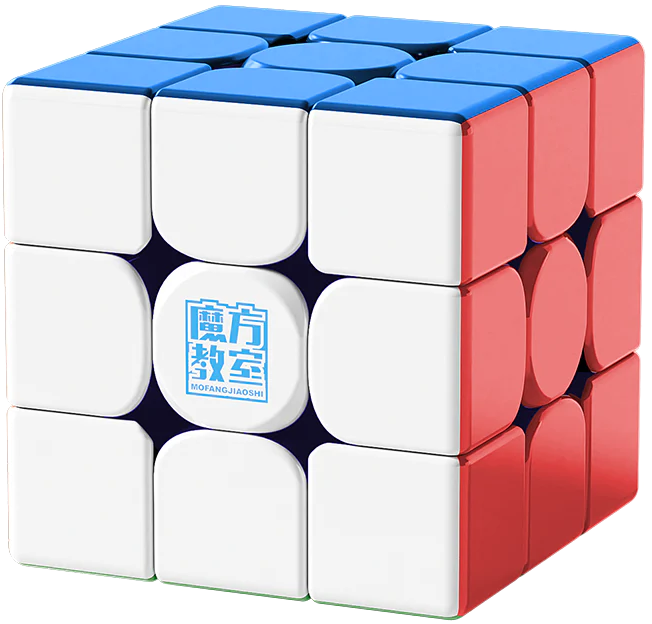 |
MOYU RS3M Super V2 –
|
Gone is the blockiness and clackyness of the RS3M that so many of us have used and abused (the RS3M2020 remains, to date, the single-most purchased cube according to the r/Cubers megasurvey), this is a cube that would better be described as a more stable version of the WRM2021purplev. The magnets are somewhat strong compared to older Moyu cubes, and the click are clearly felt, with the auto-align kicking in at the 60° mark. The magnet strength makes it so that you will not risk overturning even for the more aggressive cubers. With that said, the magnet strength remains closer to the Huameng YS3M than the much clickier Weilong V9.
The cube remains solid, and whilst its price tag won’t make it as much of a favorite of parents and uncles as a gift for their kids as the previous versions, this is a cube that will survive some encounters with pre-pubescent animals… sorry : “younger cubers”.
Cornercutting is perfect at most reasonable tensions, weight and strength required to turn is rather light on the looser settings, making this cube fast if you want, but the range of compression and the presence of an actual screw allows you to turn it into something stable and controllable if you prefer to.
Then there’s the looks. Here the completely coloured internals (purple or teal) look awesome, and better than the V9 (which has coloured internals for the centers and inner stems but not for the edges and corners). The result is one of the best looking moyu cubes that’s been released since the WRM2021 purplev. The center caps are round and bevelled just like in the V9 (they are interchangeable, but the V9 are a fraction of a millimetre thinner), and far better looking than the octagonal weirdness of the first version of the Super.
So this brings us to the current situation of Moyu releases : RS3M Super V2, Huameng YS3M, Weilong WRM V9 each with 3 versions : Standard, MagLev, BallCore. That’s a bit messy compared to having adjustable magnets, but maybe it makes commercial sense for Moyu, who knows. The Super v2 is now the most expensive Moyu cube, with a range that goes from 3x the price of its first iteration to more than 5x for the ball-core version. That makes it something that you might want to try out before you decide to buy.
Bas' humble advice
So which should you get? Here is my subjective estimation of the current models
If you prefer weaker magnets : YS3M > Super2 > WRM V9
If you want a cube that looks great : Super2 > WRM V9 > YS3M
If you want the best performance : YS3M = Super2 > WRM V9
As for which version of the cube?
Get the Ball-Core for the Super2 or YS3M, get the Standard for the WRM v9.
TLDR: A more solid and stable but still fast version of the WRM2021purplev that has little to do with the previous RS3Ms but remains a fantastic cube.
- Weight & feel – Average weight, with
solid pieces
- Turning Speed – Moderate to fast and very smooth
- Corner Cutting – Stellar but snappy
- Magnets – Medium strength, the click is clearly felt
- Lockups – Nope, unless you loosen its tension, but
then you should expect that anyway
- Sound – Quieter than its predecessors, but still loud
compared to other moyu cubes
- Looks – Smoother than the YS3M thanks to its beveled
caps, the dark internals look awesome
- Plastic – Solid, shiny and UV brilliant, thank you
for not making a frosted version of this!
- Similar-feel cubes – WRM19, YS3M
- Price – 24-43$ depending on which version you get (shut up and get the BallCore version)
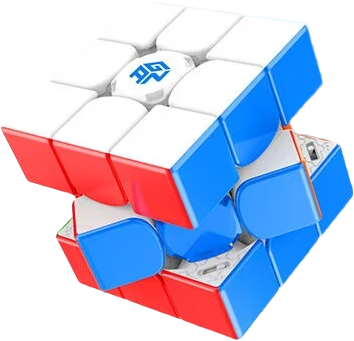 |
GAN 12 Ui – Dear Smartcubes engineers, I'm very sorry, but now we know what we can expect from you |
I've tried my fair share of smart cubes in the past 2-3 years, and while some of them have been good smart cubes (e.g. Gan iCarry) and others have been great ones (Moyu AI, Gan i3), they have never been comparable to proper speed cubes. Even the best ones had some catchiness, some extra weight or some iffy stiffness that made them chunky and a bit unwieldy. They performed well enough to make sense for training and analytics (and for some people, competing online), but when you wanted to get your real times, you'd pat the smart cube on the corner and tell it to go back to its charging box while you chatted with the grown up cubes.
This is no longer an inevitability. I have been using the Gan 12Ui for the past month and it's become my main cube for normal solving (I've broken my PBs on both CFOP and Roux within hours of starting to solve with it).
It feels like a slightly heavier version of the Gan12. And given how light (and to some extent flimsy) the 12 was, this is actually a plus. This is just perception though, as the Gan12Ui actually only weighs 1 gram more than the Gan12 (68g vs 67g), leaving it far lighter than most other smart cubes, let alone body-positivity cubes like the Rubiks Connected. The weight distribution makes it feel as if the outer pieces have just a bit more heft than in the Gan12, even though the piece design is identical with the only difference being the core-corner magnets – which protruded massively on the Gan12 and tended to catch more than one might like – that have been shortened a lot to fit around the electronic core. (Fun fact, this is actually the first Gan to sport a Ball Core). The results is less catches, smoother turning than on the Gan12, at the price of the auto-align feature that is vastly reduced on the smartcube compared to its dumdum version.
I find myself liking this one a lot for Roux. Turning is effortless, corner cutting is truly forgiving and the weaker auto-align makes slice turns less snappy and softer. If I had a gripe, it is that at 56mm it feels a bit bulky for OH on my chubby fingers. (I still managed to lower my global average on OH with this thing).
Add in the UV coating (the only surface available, thank you very much), bright shiny colors and center caps with those techy indents for the Gan robot, and a more solid plastic that is closer to the Gan13 than the see-through plastic of the Gan12, and you have a cube that looks as badass as it performs.
An added benefit of this smartcube being so good as a cube in general? I don't care about battery life anymore : once it's out of juice, it remains one of the best cubes I have, instead of becoming a coloured brick that needs to wait for electrons to pour in. Not that I find myself with low battery often, mind you. On a full charge I can't really deplete the batteries in their entirety (my life doesn't let me cube for more than 4h straight anymore), so if you remember to store it in its box in between sessions you'll be perfectly fine. The only situations in which I ended up having low batteries were when I forgot to charge the battery box itself (it is a glorified 1000mAh powerbank that you can't use to charge anything else than a cube).
A discussion about software is not really germaine to this review. But it needs to be said that the cube can be connected to most modern cubing app that use bluetooth (Cubeast or Briefcubing to cite two). You need to obtain the MAC address of the cube itself from the GAN Cube Station app, but you can then leave that ghastly piece of software alone after that. Unless you like baroque user interfaces and you want to use it (in which case you'll be able to get gyroscope information about rotation, which you don't really get with, say, Cubeast).
The only true drawback is not a small one: If you live in the West you can't really buy it. The product is currently not marketed outside of China, which is why you can't find it on GAN's own stores, and have to resort to independent distributors on Chinese platforms to get one. Not a difficult thing to do but delivery times are long, AND customer support is mostly inexistent: The first copy I received had one of the 6 faces that was not registering/sending moves, which makes the smart part of the cube inoperable. Give credit where it's due, GAN support staff was super friendly and quick to respond, but said that the only way for them to be able to help was to send the product back to the seller in China. The realities of customs fees and shipping are such that it would have cost the same amount as buying the cube all over again just to have it repaired/replaced and shipped back. I ended up purchasing a second copy, that fortunately had no issues whatsoever, and am happily using the non-working version as a dumb cube for travels (plus I get an extra charging box for the office). Hopefully I was particularly unlucky and the 50% hit ratio for factory errors I experienced is not representative of the reality of quality control and technical failure of this cube.
The last point is one that needs to be considered in a GAN context : factor in shipping costs and customs fees and this cube costs between 140$ and 150$. That starts to be expensive even for people who have jobs. It is 2x the price of a flagship GAN cube, but it's nearing FIVE times the price of many other smart cubes. That is ridiculously expensive, but it is also a smart cube that stands on a tier of its own. I'll re-iterate : no other smart cube, from any brand (GAN included) comes anywhere close to the performance of this cube as a speed cube. It is going to be too expensive for many (most?) people. But if you can afford this, it is the current state-of-the-art in cube technology.
Would I recommend it to anyone?
If the risk of technical issues is indeed high, I would say no. I am lucky enough to have a steady source of disposable income that lets me sustain the hit of one very expensive cube for the sake of writing a review, but having to dunk almost 300$ on a non-collector cube because you were unlucky does not sound like a great deal. The very reasonable alternative is to wait for it to be released in the West. But given that the I3 and iCarry S have only recently been launched here, it might take a while before that happens (2024?).
With that said, if you were going to invest that money into NFT, then you might as well get the best smart cube in the world right now, and one of the best speed cubes available today.
TLDR: One of the best cubes available today, that happens to have electronics inside that let you connect it to digital devices.
- Weight & feel – beyond light, pieces move
like bubbles on air
- Turning Speed – fast!
- Corner Cutting – stellar
- Magnets – average to strong depending on setting,
aim-bot is reduced compared to Gan12
- Lockups – Gan12 issues with core-corner magnets
catching have been completely solved : this thing will never
lock on you
- Sound – God this thing is loud. sound is very crunchy
- Looks – Shiny UV surface, sharp bevels and clean
internals. This thing is flashy and beautiful. Plastic is more
solid and less see-through than on Gan12 (similar to Gan13)
- Plastic – Very crispy, you don't get the feeling this
thing will break if you squeeze
- Similar-feel cubes – Gan 12 Pro, Gan 13, Gan 11 M Pro
- Price – 140-150$ depends on customs fees (only
available from China)
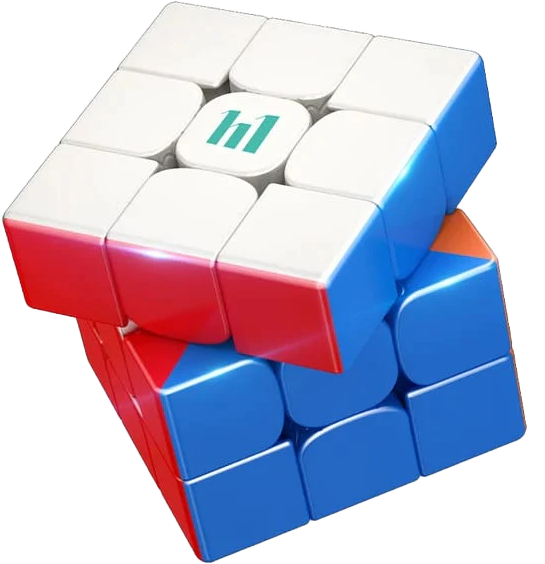 |
MoYu Huameng YS3M – Yusheng, you steely eyed engineer! |
This is not a fast cube: it’s a stable, reliable, forgiving, solid cube that let me get my normal averages within 10 minutes of unboxing it, with some really fast solves coming out of the blue. The base tensioning is rather tight, which is going to be very good for beginners, as it helps them acquire the dexterity that will carry them to good performance once their brains catch up with their fingers. Due to that, however, it requires more force to turn than other cubes I’ve been using recently (chief among them the latest GANs), meaning that dishing out several AO100s without making a pause might lead to some pain.
Corner cutting is as good as we know Moyu can make it, but it is on the snappier side (i.e. you start pushing and nothing happens until it cuts all the way in one snap, in contrast with other cubes that gradually cut from the moment you start pushing). People who are still measuring how many degrees a cube can corner-cut will be able to pat themselves on the shoulder and pretend that 45° is a reasonable angle on which to start your turns (pro tip : it isn’t. If you’re that far back with your turn as you try to cut, the cube ability to let you do it is not going to be the biggest hindrance in your solving).
Roux solvers tend to like Moyu cubes and this one will be no different: slices are great to execute and its smaller size makes it very nice for one-handed solving. And for the CFOP solvers who still believe MU versions of U perms are better, you’ll find here a cube that lets you get away with some inaccuracies that wouldn’t work on many other cubes.
There are no adjustable magnets. And that’s ok. Sometimes engineers have enough testicular fortitude to decide what settings will be good with their cube. And if Yusheng Du has indeed participated to the design and fine tuning of this cube to the extent that it has been advertised, kudos to him for finding magnet settings that work great with this cube. And if it wasn’t him, kudos to the unnamed engineer that made it happen instead! (Note: this is the case for the YS3M BallCore; for the others… I don’t care about the neutered versions of this cube, and neither should you.). The magnets are relatively clicky for a Moyu cube, more in line with the GST3M (not LM) than the older WRMS.
The cube is not very quiet. It shares the loudness of the RS3M but without its signature clackiness. Nothing major, but expect people on the train or at the next table over to look askance at you more than if you were using most Moyu flagships from the past 3 years.
The plastic is solid and reminiscent of the WRM21, without the blockiness of the RS3M. The frosted finish is just one way to make the cube suck for most people until you’ve done half a thousand solves and it finally wears off. If Moyu can realise that 80% of cubers prefer non-frosty surfaces, maybe they’ll stop making their cubes temporarily worse for no reason. The UV version is awesome though : grippy and shiny from the start, it’s a pleasure to use out of the box. Definitely worth the two or three extra coffees in cost.
And on the topic of its multiple version, I have to tip my hat to GAN for making it clear which of their cubes are the real ones, and which are the el-cheapo variants for people who can’t afford to sell their kidneys every time they want to purchase a new cube. Moyu and XMD have not gotten the memo yet, and come out with different versions all at once, sometimes not making it truly clear which version is best (Dear XMD, please don’t call “Standard” the version that has none of the nice stuff from the cube you originally designed). Combine this with the fact that they decided NOT to have customisable magnets, and I can imagine the discussion at Moyu Headquarters:
Engineers & holder of the WR single : "We think we'll have a better cube if we make some of the important choices ourselves and don't give to the user options to mess up the balance of the cube"
Moyu Marketing team : "Sounds great! Now make 4 variants of the cube where you gradually strip them of all the things that make it good"
Engineers : "Can we at least NOT make the plastic frosted?"
Moyu Marketing team : "Nope, we need frosted : parents who buy cubes for their kids think they look great"
P.S. Dear Moyu Marketing team, next time I ask you to send me a preview of one of your product, please disregard the preceding paragraph.
If you need to choose, allow me to help you here : get the UV BallCore version and ignore all the others. If you can’t afford it, buy a Super RS3M, or better yet, go help your dad tidy up the garage next Sunday or your mom shopping for groceries on Saturday and ask them to chip in for the 10$ difference.
For the people who are reading this in the first part of 2023 and are asking themselves what cube to buy, this is definitely one to put on the list. Should you get this instead of a Tornado v3 or a Gan 13? It’s a clear contender for best cube available as of right now, but preferences will vary.
Bas’s quick guide to cubes in April 2023
- Want a smaller cube? Get the YS3M
- Want a quieter cube that is more flexible? Get the Tornado
- Want a cube that requires almost no force to turn? Get the Gan13, or better yet, the Gan12UI (yup, you heard me right, that smart cube is better than most speedcubes)
TLDR: A stable, forgiving and smooth update to the old GTS and WRMs, with new technology, no unnecessary customization and fantastic performance. One of the best cubes available today.
- Weight & feel– Average weight, with solid pieces
- Turning Speed – Moderate and very smooth
- Corner Cutting– Stellar but snappy
- Magnets – Medium strength, excellently balanced
- Lockups – Nope, unless you loosen its tension, but
then you should expect that anyway
- Sound – Not as loud as the RS3M but not a quiet cube
by any stretch of the imagination
- Looks – An interesting mix of RS3M look (with colored
internals) but the sharper outer surface of the WRM21. A
modern, sharp look
- Plastic – Solid, shiny and UV brilliant, unless you
got the frosted version, in which case that's your fault
- Similar-feel cubes – RS3M, GTS2/3, WRM19
- Price – 35$ unless you want a stripped down version, which you shouldn't get
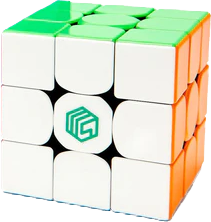 |
Diansheng MSCube MS3X – Dear MSCube Engineers : grow some algs and make some choices yourselves. Also, great cube! |
Turning is not the fastest but doesn’t require too much strength. Magnets are rather clicky (a bit strong for me) and cannot be adjusted on the fly. If you have 30 minutes to spare you can swap them out for weaker or for stronger ones, I find the best for me is removing them entirely and stick to the traditional corner-edge magnets only. The choice of center-to-corner rather than core-corner magnets is an iffy one: the Valk Elite and MS3-V1 both tried some versions of that before and failed. This one doesn’t seem to be a game changer either, and switching from attracting to repelling (the only change you can make easily) has no noticeable effect. Corner cutting is excellent across multiple tension settings, and the cube, although light, feels sturdy in the hand. Plastic is blissfully not frosted, and colors are a bit muted (which suits me, but might not pop out enough for others). Overall a good cube on which I can get good times after a couple of hundreds of solves.
Compared to its predecessor, the spring system is much simpler and much better to use: easy to turn by hand with a range of compression settings that is well calibrated, and a simple screw to adjust travel distance. The MS3-V1 had an obscurely weird double springiness system where you could flip the internal parts to… do something. It ended up not being good at much. This one does what it needs to and lets you understand how easily.
However, all the engineering prowess that they DIDN’t put into screwing up the spring system was instead dedicated to bloating the rest of the cube with needless stuff. Which brings me to the interchangeable pieces and the ludicrous level of customization. There is such a thing as too much freedom of choice. Want an additional torpedo on the edges? Pull it out (and hope you’ll feel a difference)! Want an entirely new set of magnets? Here are TWO of them for you to play with! You think your core could be improved? Here is a replacement one with different colors. Don’t know what the effect will be? Neither do we!
A word of advice to the MSCube (and now Diansheng) engineers. It’s YOUR job to make design choices that make the cube perform better. Leaving it up to the user to this extent is just feckless and cowardly. If you don’t think there’s a real advantage to having torpedoes, don’t put them in. And if you can’t say whether it makes a difference, how do you imagine a layperson might be able to? In either case, drop it and reduce complexity and costs. And the fact that all other manufacturers have found a way to let you change magnet strength without spending 30 minutes unscrewing all the center pieces and pulling things out by hand means you are doing it wrong. (A side note: for all that you get a replacement piece for almost every single part of the cube internals, they could have added a screwdriver to actually change the travel distance)
But despite the shortcomings of the R&D department decision taking (lazy design is neither new nor laudable), this is a cube that performs very well, clearly part of the new generation of cubes that provide a snappy feel, high control and great forgiveness.
Is it at the level of the current beasts at the top of the ladder (Gan13, Tornado3, WRM21purplev)? No. But it’s definitely on the higher tier, and if you’re looking for something that feels a bit different, this is a good cube to have.
TLDR: A good cube with solid performance, with too many interchangeable settings that you will never use.
- Weight & feel– Light, feels a bit papery
- Turning Speed – Moderate to fast (depends a lot on
settings)
- Corner Cutting– Very good on most settings
- Magnets – Standard magnets are clicky and not
adjustable, internal center to corners can be swapped if you
have a lot of time and patience
- Lockups – Rare on tighter settings, but never a major
issue
- Sound – Clicky and a bit crunchy, rather low pitched
and pleasant
- Looks – Still looks like an old Gan, which is not a
bad thing
- Plastic – Somewhat muted shades, and almost glossy
(yay!)
- Similar-feel cubes – WRM 21 maglev, Gan XS, MoreTry
Tianma X3
- Price – 30-35$
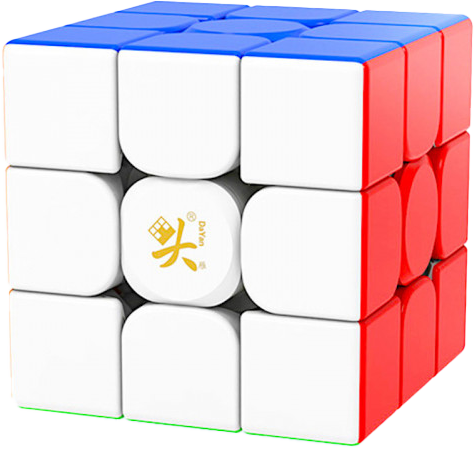 |
Dayan Tengyun – If at first you succeed...
|
The third iteration of the Tengyun series retains the quietness that was characteristic of its two predecessors, but unfortunately shares the lack of stability, random lockups, loss of cube-shape and pops that marred the performance of the Tengyun V2, rather than the ultra-fast and solid reliability of Tengyun Senior.
Nevertheless, this gives me a long coveted opportunity to vent some of the frustration I have had with the Tengyun V2 since it came out, as Tengy the Third is far closer to it than to the progenitor of the series. The first Tengyun was and remains to date one of the most beloved cubes around, it is a very common sight at any comps, much lauded by many, e.g. in the BLD community. It combined a very solid feel with incredible speed, without sacrificing stability. Magnets were well calibrated to its other features (though to some they were too weak), and springs had a very distinctive stiffness that made it feel as if the entire layer was hovering on air just waiting for you to turn it. It was a cube that had the performance of something like the GAN flagships of 2021-22 but time-traveling back to the beginning of 2019.
Then something happened. Historians are unclear on whether the meth-addicted cousin of the original Tengy designer was hired to replace him, or if someone lost a bet, or if the spawn of a wealthy donor wanted to try their hand at designing a cube. But the resulting “version 2” was an over-engineered clump of plastic that felt very buttery, was even more silent than its forebear, and couldn’t keep its cube shape if you left it on its own on a table. The spring system was cumbersome, with a ton of settings that let it range from bad to still bad, and was too unreliable on any settings to be viable as a main for all except the most dedicated masochists. But enough about history. We’re in 2022/23 now, and Dayan has decided to time travel again and give us today a cube that could have been made five years ago, which feels rather buttery, is somewhat silent and can’t keep its cube shape if you leave it on its own on a table.
The customisation is a big aspect in which this cube reeks of 2016: while all new cubes coming out now are sporting one or another version of core magnets and maglev “springs”, the Tengyun3 provides 3 sets of nuts to achieve different travel distances that you have to painstakingly remove and replace one by one. The springs are set in their own plastic casing reminding heavily of the GES system, which is just not old enough to be retro yet, also, they will yeet to the moon if you make the error of twisting them in the wrong direction. The result is something a tad less complex than the horror that was the Tengyun V2 spring compression system, but which doesn’t solve its issues either, resulting in a cube that even when too tight for comfort manages to lose shape faster than me during the holidays.
Also, Dayan still hasn’t understood the nuances of modern language : “a cube that drips” doesn’t mean that it should literally sweat factory lube when you take it out of the box. Mind you, I’m as insensitive and inured as the next person about the perils of climate change, but even I am feeling sorry for all the baby silicons that are being slaughtered here. (Oh well, at least that’s one thing it still has in common with the first Tengy.)
All in all, the performance of the cube is in general bad. But this is mostly due to how unreliable it is. When you don’t get any lockups or downright pops you can solve very fast and smoothly on it. But unfortunately you do get those, and too many for comfort. Even after several AO100s I’ve been unable to get anywhere close to my usual times, but I did get some pretty fast singles.
And at the same price as the Tornado v3 Flagship, I can unfortunately recommend this cube to no-one except very dedicated collectors.
TLDR: The first was legendary. The second was terrible. The third is just as bad.
- Weight & feel– average weight, with somewhat
sharp edges, feels buttery
- Turning Speed – moderately fast
- Corner Cutting– ok on loose settings, gets bad pretty
quickly when tight
- Magnets – adjustable from clicky to more clicky
- Lockups – Oh god yes, and loss of cube shape, and
pops.
- Sound – Very quiet. Maybe not as quiet as the Tengy2,
but definitely up there
- Looks – Very fluorescent yellow might put some people
off, it has that Dayan sharpness of their last 3-4 models
- Plastic – Solid, somewhat sharp, frosted but not too
much
- Similar-feel cubes – Tengyun v2, MSCube MS3-v1
- Price – 30$
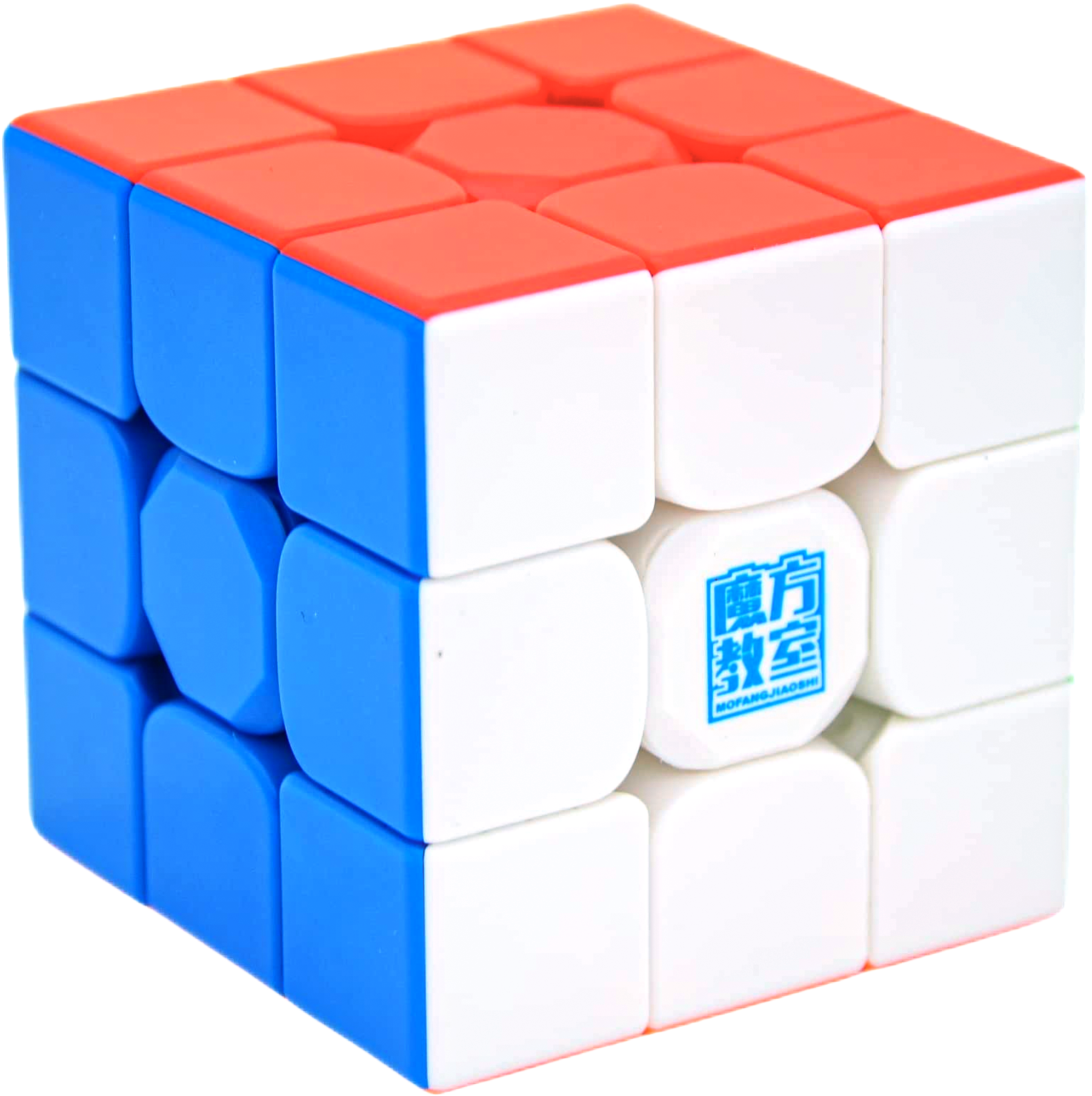 |
MoYu RS3M Super – It's a Boy!
|
While the feeling of this cube is very similar to the RS3M20/21 (I consider them the same cube with different tension ranges), the addition of the core magnets allows it to be used at a lower tension but still retain good control. This means you don’t have to feed it enough lube to satisfy a grown panda bear, as you’ll be able to get something controllable without forcing it to be slow.
Finding good settings is going to require some finicking: on very loose settings it overshoots and is too fast and difficult to control. Tighten it to something more reasonable, and it will lock up often, and corner cutting is going to be lower than my IQ before my 9am coffee. I’ve found that setting spring tension to DAS-1/2 and loosening the screws a bit works well for me, and make it very pleasant to use.
This cube will demand some patience, as it comes with the frosted plastic that looks oh so nice, and feels oh so sh*tty, meaning you’ll have to do a couple of hundreds of solves before you can actually get good times with it as the frosting finally wears out and you don’t yeet the cube across the room every 4th solve anymore. For reference, my first AO100 was ~30% slower than my usual average, my 3rd one was within 2% of it, so it doesn’t take THAT long, but if you’re just testing out the cube to see if you like it, make sure you are testing a broken in version.
I am still on the fence on whether putting a surface protecting the core magnets is a necessary design choice. (For those not in the know, the so-called “ball core” is a thin layer of flexible plastic that encloses all the core magnets... and reminds people of that particular biology class in middle school.) When you rotate the pieces around you can see that it allows the corner-magnets to slip past the core magnet without the bump and locking that both the Gan12 and (in a lesser measure) Tornado3 sometimes showcase. But it means that you won’t be able to swap cores around, re-glue things that might pop-off, or apply other modifications, without first removing the entire contraption. (UPDATE: XMD found the Moyu idea to be good enough that they switched their core magnets to a Ball system as well. I suspect this is going to found on almost all new cubes coming out now. Good on you Moyu!)
The weight of the ball core version is around 88 grams (about 4 grams less for its female counterpart, and about 9 grams less for their neutered smaller sibling). It is perfectly reasonable and far from being the beast of a cube some people were fearing. The plastic feels solid and it manages to be less loud than the previous versions, mostly thanks to the lack of big clacks coming from pieces landing down from a big corner-cut. The combination of solid plastic, fast turning and good control reminds me of the WRM19, so that can't be a. bad thing.
A quick point on the center cap design: I’ll be damned but they actually look and work great. I like the sharper design, reminiscent of the Meilong M but from this decade, while retaining those tiny holes that make it great to pop off, even for people who think fingernails are perfectly reasonable snacks. Also, the fact that the inner part of the center plastic is coloured lets you put back all the caps without having to think.
The magnets are well balanced : the overall strength is on par with the medium settings on the latest Gan and Tornado3, but the heavier heft of the pieces moving around mean the feeling is less clicky. The core-corner magnets allow the magnetic bump to not be disturbing and the cube retains its shape while turning most of the time.
But then there's its lockiness, which reminds more of the Meilong M than the RS3M 202x, and will sometimes screw up your solve for no good reason when you get to last layer. In one sense that’s not bad, it will force you to turn accurately (the locks come mostly from unforgiving corner cutting), but for people who like to be a bit aggressive with their cubes, this might not be great.
To close up, the price of the RS3M Super is getting uncomfortably close to flagship level cubes (if you can pay 20$ you can probably pitch in 5$ more for the much better Tornado v3). The more economic versions are more similar to the RS3M20 and 21 respectively. Wonderful quality for the price, but nothing new since Moyu had the crazy idea of making great cubes at unconscionably low prices.
TLDR: A more controllable but faster version of the RS3M we’ve come to know, the Ball Core version is nice, but the other versions are great, more economic options
- Weight & feel– average weight, with solid blocky
pieces
- Turning Speed – fast to moderately fast, core magnets
help with control (lube to slow down for standard/maglev
versions)
- Corner Cutting– Not great, but good enough in most
cases
- Magnets – Medium strength, very reasonable and well
adjusted for its speed
- Lockups – Yes. More than you would expect from a
RS3M, about as much as you get with the Meilong M
- Sound – Less loud than the previous RS3M, mostly due
to the fact that it is more controllable and will not clack
down after a bad corner cut (to be honest it will lock up
rather than clack)
- Looks – The center caps look great : a modern version
of the Meilong M makes overall looks more premium than its
predecessor
- Plastic – Frosty until it thankfully wears off, solid
- Similar-feel cubes – RS3M, Meilong M, WRM19
- Price – 10-20$ depending on version
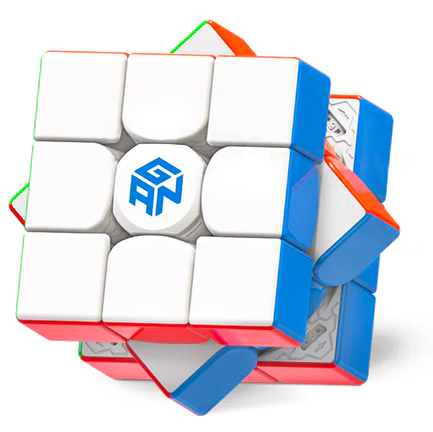 |
GAN 13 Maglev – The price tag is ridiculous. So is its
performance.
|
It looks great. The UV coating (get the UV version, don’t be a moron) makes this shiny, but in contrast to its predecessor, the plastic is solid and not the see-through gossamer that the 12 was made of. And since we want our pretty things to look pretty, they actually made THE BOX out of frosted plastic, which indeed looks gorgeous. And since you don’t have to turn THAT (although the box itself does have more magnets than most cubes from 2015), it means you can have the fancy looks and the good cube. (Also the combination of shiny cube inside frosty box will make cubeographers swoon for a while, expect avalanches of “cube in box in grass with bokeh” on our social media platforms in the months following this cube coming out to the public.)
The turning is the same effortless breeze that both the 11 and 12 have made us know it’s possible to have. You need only apply a minimal amount of force to turn things smoothly. Moreover, the amount of force necessary to initiate a turn is very similar to the one you need to keep turning (until aimbot takes over, more on this below). Compare this to most other cubes where the initial "un-click" requires more force, this means you can enter a solving flow that is more difficult to reach with other cubes.
The range of settings on this thing is majestic. First, the tension and travel distances are actually able to turn this cube into a thing as loose as my grampa’s tongue after a few glasses of grappa or as tight as my wife’s wallet when I mention that a new cube has come out. That means that after a bit of systematic testing you can find the sweet spot that fits your turning the best. Combine this with a range of magnet strengths that Gan has never been able to produce and you have a cube that is as versatile as something that costs this much should be. The only gripe I have is that the tensioning system is a tad iffy, and sometimes locks up trying to cycle through the settings, forcing you to turn all the way around 2-3 times to get the exact value you wanted. (Credit where it’s due: placing the adjustment tool inside the box is a brilliant idea.)
As for the magnets… This is the first time I think a Gan cube is viable for Roux, as you can actually get magnets weak enough to avoid the familiar Gan clickiness, and makes the inner slices very smooth and pleasant to turn. Combine with its fantastic corner cutting and you have a lot of fun doing LSE. Having 6 different settings instead of three on the previous versions also means that you can fine-tune the amount of magnet hold you find appropriate for the tension settings you are using. This means more time tinkering with the settings, but you invested the cost of 30 cheap cubes in this thing, you probably want to turn it into the most efficient cubing machine possible. And this cube lets you do it.
The Gan 13 sports the same auto-align feature as its predecessor, which on lower tensions & fast settings means you seriously risk overturning to the point where the aimbot takes over. This means you need to be more careful and apply the minimal force possible to avoid that. Given that this is generally a very good approach to have in cubing, in a sense the cube is forcing you to git good. It also means that for novices this might not be the best solution (then again novices shouldn’t be investing the price of the past 3 years of Moyu flagships into a single cube either).
And then we get to the price tag question though. Taken in a context where we’d have no idea of what a cube costs, it would not be too surprising : That a cube this good would cost 3 times the price of a Rubik’s branded one would not raise many eyebrows. The fact that for the same price you can buy all 3 versions of the Threemato – which came out basically the same week – makes it a very relevant question whether this cube is worth the price. And my answer is yes if you can afford it. This is one of the best cubes that exist right now and if you want to have it, you won’t feel like you’ll have wasted your money on it.
But Bas : should I get this one or the Tornado V3? Easy: If you're on a budget or are starting out as a cuber, get the Tornado. If you can afford the Gan13, get both.
TLDR: This is one hell of a cube. Its price sets it apart from all other cubes, but its performance is matched only by a very few cubes.
- Weight & feel– average weight, with solid pieces
that don’t feel hollow
- Turning Speed – ridiculously fast to moderately fast,
slow down for control
- Corner Cutting– glorious when loose, perfectly good
when reasonably tightened
- Magnets – OMG, a Gan without clicky magnets (but can
also have them!)
- Lockups – Overturns? Yes. Messing up your algs? Yes.
Lockups? Never.
- Sound – Not as loud as the 11/12, but still one of
the loudest cubes around
- Looks – Technically identical to the 12, but the
thicker plastic make it look more solid, less translucent,
nicer
- Plastic – Sharp, solid, UV-glossy!
- Similar-feel cubes – Gan12, Gan XS
- Price – 75-85$
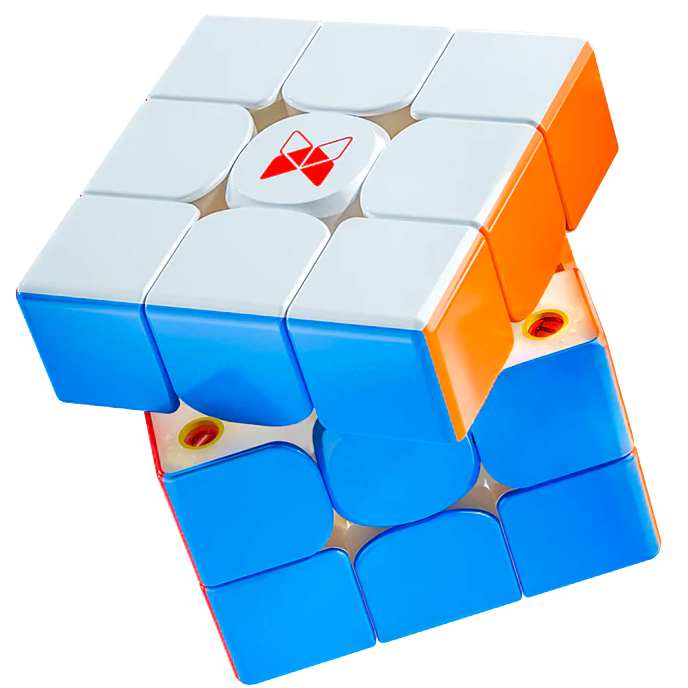 |
X-Man Tornado v3 – How to recycle a name for an
entirely new cube
|
The pieces feel solid and sharp in a way that reminds Dayan’s Zanchi Pro (although not as knife-edges sharp as the Guhong v4), but without the wonky springs and lockups (I tested the non-maglev Flagship version). It is very fast and requires minimal force to turn, but you do feel the friction of the pieces as you move things around (contrast this with the first Tengyun, where pieces feel similarly solid, but give the impression of hovering atop the core axis, rather than on the central slice).
The adjustment system inherits from its previous version with a twist : you don’t need the plastic bident tool anymore to adjust it, which is very practical (RIP fantastic multitool though!). Unfortunately getting the caps off the centres is so bad that you’re better off using a tool to pop them off (especially on higher tensions) which somewhat beats the purpose of not requiring a tool in the first place. With that said, the adjustment is even easier and more intuitive than before, as you can now feel the tightening and release as you rotate through the range of settings.
Magnet are quite clicky. Part of it is the noise (you can clearly hear a grigrigri sound as you turn even on the lowest strength), and part are the core magnets, that add an overall level of magnetisation that you can’t adjust away. That said, the fantastic stability they provide makes the clicks a very reasonable price to pay (if you don’t actually like them).
Quick Tip: The core magnets are clip-on, meaning you can simply remove them and get a Standard or Standard-Maglev version with non-clicky magnets, as they remove a part of the total magnetic force, roughly equivalent to putting magnet strength to a theoretical -1. If you don't like strong magnets this might be a great thing to do! (You can put the core magnets back at any time, clipping them in is very easy, but be careful as they might unclip during solves and completely lock up your cube.)
Corner cutting while solving is excellent. I rarely find myself locking up mid-solve, even if it is possible to lock it up if you try to explicitly. The combination of stability, magnetic feel, corner cutting and springs make this a ridiculously forgiving cube, on which I’ve been hitting faster times than usual both in CFOP and Roux. I suspect people with very high TPS will find this cube very very nice.
On this latter, the slices require a bit of effort due to the core magnets making your life more difficult and yielding the only (rare) lockups I get on this cube. But overall the leniency of the cube overall makes me get good times for my mediocre skill level. If Roux is your main method, however, I would probably suggest to get another cube.
As for those who’d like to know how it compares with the Tomato v2, they are two pretty much distinct cubes with few similarities: It sports the same center caps and an even better adjustment systems. However the differences are more important: It is larger, louder and with a higher-pitched overall sound, it feels heavier and with clicker magnets. It is also more forgiving and less prone to lock up, and provides a more sturdy alternative to other TPS favorites like the newest GANs, which tend to be flimsier and more prone to damage. All this at 1/3 the price.
Update: What are the differences between versions?
I've been able to test all three versions of the cube, and I'd say that they are minor variations on the same theme. The main difference between Standard and Flagship is being able to reduce the magnet power even further. Difference between Pioneer and Flagship is less noise and a range of spring compression setting that is more shifted toward the "loose" (I've been doing a lot of OH on the Pioneer and I'm quite a fan). Oh, and you can pop off the center caps without getting your fingers to bleed. Imagine that.
If I had to summarize what to choose, I'd say:
- Want something with non-clicky magnets? --> Get the Standard
- Want something with super light turning? --> Get the Pioneer
- Want something in the middle? --> Get the Flagship
- Don't know what to get? --> Get the Flagship
TLDR: A completely new direction compared to the Tomato2, it’s a great cube especially if you turn fast.
- Weight & feel– average weight, slightly
papery feeling when turning
- Turning Speed – fast, but very controlled
(thanks to core magnets)
- Corner Cutting– very good, difficult to make it
hard lock midsolve
- Magnets – clicky even on lowest settings (mostly
due to core magnets)
- Lockups – Some lockups after slices, as they
require a bit more force than normal turns
- Sound – Definitely louder than its predecessor, but
not a “loud” cube in any way
- Looks – You had me at glossy plastic. It sports
the same bevelled center caps of the v2 but the white
internals give it a very different look. (Old grumpy me
prefers the older look.)
- Plastic – sturdy and sharp, glossy (yay!) and
feels thick and solid.
- Similar-feel cubes – Zanchi Pro (sharpness),
Tengyun 1 (solidity), MG C Evo (paperiness)
- Price – 25-40$
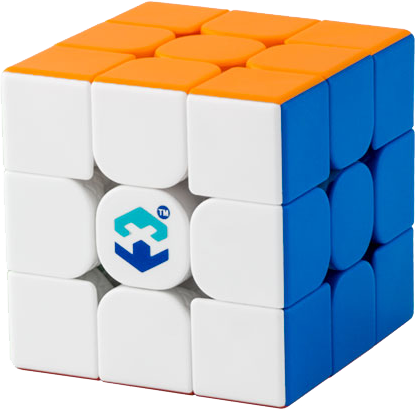 |
MoreTry Tianma X3 – It's a great cube that feels like ©#*† |
The cube is very fast, it sports the same effortless stiff turning that you find on the first Tengyun and the Gan12. Of this latter, it also has the same auto-align feature, which some love and others feel awkward at least until they get used to it. The magnetic click is very pronounced, among the strongest from recent cubes. Because of the heft of its pieces (this thing is nowhere near as light and gossamer-like as the Gan11/12) the inertia of pieces overshooting creates a vibration that makes the whole cube wobble a bit.
It's difficult to talk about corner-cutting for this cube, as the auto-align feature makes it never have to happen. If you really try, there's a narrow spot around the ~70 degrees where the cube will lock up, but good luck making that happen mid-solve. Slices are not great, the strong magnets don't let things flow without effort, and while for M slices that can be compensated with a bit more effort, S and E slices feel like scraping a bunch of Lego bricks together from the wrong side. Roux solvers might want to stay away from this one.
And yet, despite all that, the cube is not bad : it takes very little effort to turn, it is extremely forgiving of errors and overshoots.
The noise is loud and not in a good way, between the hollow pieces and magnet clicks it is a constant brrrrrrr, and not of the good kind . Its redeeming quality is that the pitch is rather low and the cube doesn't clack, but this thing is in no way silent. In terms of build and feel, they tried, and failed, at giving it a shiny look just like the current GAN flagship, but in the end it looks and feels like a clacky Yuxin Little Magic.
And finally, customization, or rather its lack of any. Yes, you can opt to buy a version with fewer magnets (I tested the Triple Magnetic version), and maybe that's going to be better for you. But since you won't know beforehand what might suit your style best, that's not as great an idea as the marketing team at MoreTry must have thought. Also, I ordered the maglev version but received a springed one instead, which indicates that the difference is not easy for vendors or resellers either. Not that I'm complaining, this thing already has enough magnets to feed a small family of metal golems.
TLDR: This is a good cube that feels very cheap but actually performs pretty well.
- Weight & feel – average weight, but you
feel the pieces' inertia when turning
- Turning Speed – fast, but very controlled thanks to
magnets
- Corner Cutting – stellar, with no hard locks
- Magnets – strong and clicky, non-adjustable
- Lockups – none
- Sound – loud and low-pitched
- Looks – The shiny plastic has molding bumps on all
corners that give it an overall cheap look. For the rest it
looks like a Moyu cube. I like the logo though.
- Plastic – sturdy. Technically high quality, but feels
cheap. However: shiny!
- Similar-feel cubes – Gan12, Tengyun 1 but with a ton
of magnets
- Price – 25-35$
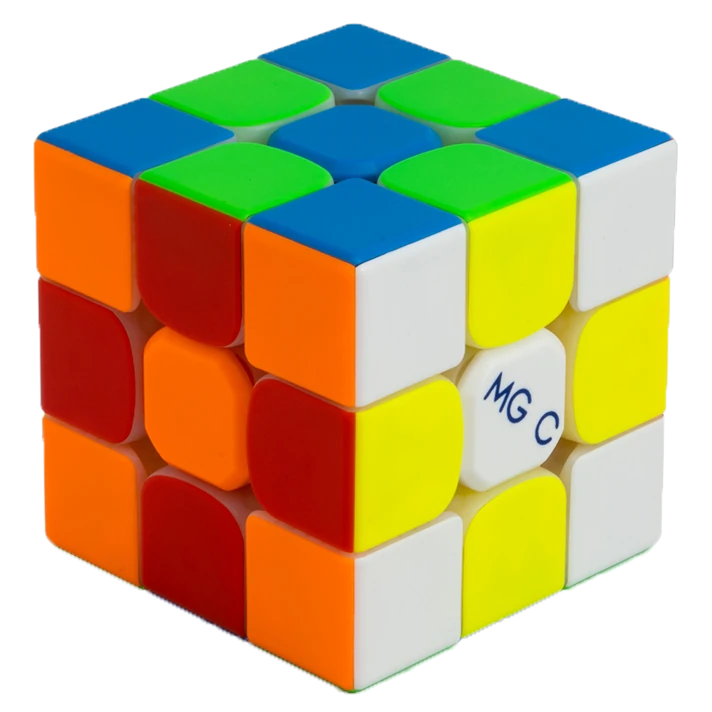 |
YJ MGC Evo – It's a Gan12, but made out of paper |
Magnets are average, and keep the cube together most of the time (I sometimes screw up my J perms because of badly executed F moves that become wide Fs). The range of settings for the magnets is non-existent, to the point that you're never sure whether 6 is the strongest or weakest setting. The spring compression system is very easy to use and read, and the 10x settings are very well calibrated, allowing to go from very loose to very tight. There are no screws to adjust the travel distance, but the default works pretty well and adjusting the compression is enough to give a range of feelings. Also, can you please stop with the bloody frosted surface already?
You'll have some trouble getting this cube to lock up, it is extremely forgiving and corner-cuts smoothly in any real-life situation. Slices work very well making Roux solving very pleasant. Overall it is a fast cube that's effortless to turn, has a great new feel and sound with papery undertones and allowed me to get my usual times within 30min of playing with it.
TLDR: This is a great cube that feels different from most cubes I've tried.
- Weight & feel – average weight, pieces
feel light when turning
- Turning Speed – fast, but not uncontrollable
- Corner Cutting – stellar, with no hard locks
- Magnets – average, little difference between weakest
and strongest settings
- Lockups – none
- Sound – very quiet, papery sound
- Looks – octogonal center caps look bad, but go with the overall "sharp" look
- Plastic – sturdy and high quality, frosting
thankfully wears off
- Similar-feel cubes – Gan11/Gan12, Valk Elite
- Price – 20-25$
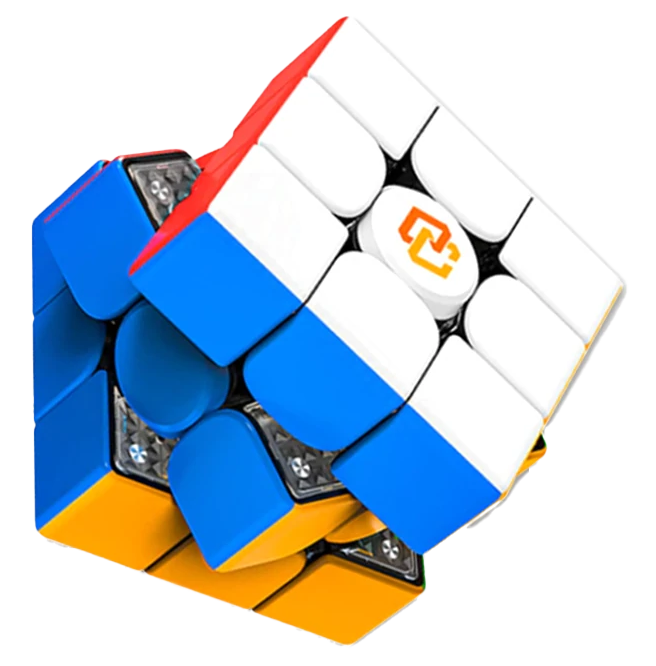 |
Peak Cube S3R – It’s a Tornado v2, but blocky, noisy,
and with IKEA’s approach to customisation
|
Nor does it have the performance of a flagship cube. The corner cutting is in line with that of most cubes coming out since 2019, but it does tend to hard-lock when it doesn't cut, which happens during normal solves (at least if you're as bad as me at turning).
The transparent inner surfaces look awesome but make weird squeaks for some reason. Swapping them does change the feel of the cube a bit, but frankly not more than adding denser vs more liquid lube. It doesn't solve the issue with lockups, nor the overall blockiness of the pieces. Magnets cannot be adjusted and tend to be on the strong side. That doesn't always work to its advantage, and makes slices less smooth than is comfortable for my Roux solving.
A note on customization : the DIY approach is an interesting idea, but it means spending 1+ hours taking off pieces trying to not destroy the plastic inserts to make them usable once again. The springs get entangled and require 20 minutes to separate out and insert, and having to replace the "screw" stopper entirely to change spring compression takes a ridiculous amount of time. It reminds me of the core-swapping, spring changing and Frankubestein hybrids that cubers used to put together 6-7 years ago. Today you can just buy another cube if you want a different feeling. And given the price of the S3R, you can buy 2-3 world-class cubes for that price and need a lot less time to set them up. Fun fact: the center caps are very well designed, and come off very easily compared to cubes where taking off the caps quickly would be more useful (as you can change their settings quickly). Interesting that of all the places where they could invest good design, this is where they decided to do it.
TLDR: If this was a 10$ cube I'd say "It's awesome for a cheap cube". At 4x that price it is not something I would advise anyone to buy.
- Weight & feel – light cube, but pieces
feel blocky and heavy when turning
- Turning Speed – relatively fast
- Corner Cutting – average, generates some
lockups during solves
- Magnets – strongish, non-adjustable
- Lockups – depends on turning style, but they do
happen
- Sound – loud, crunchy
- Looks – a clone of Tornado2, but the transparent inner sides look slick
- Plastic – very solid and compact, feels a bit on the
cheaper side
- Similar-feel cubes – XMan Tornado v2
- Price – 36-40$
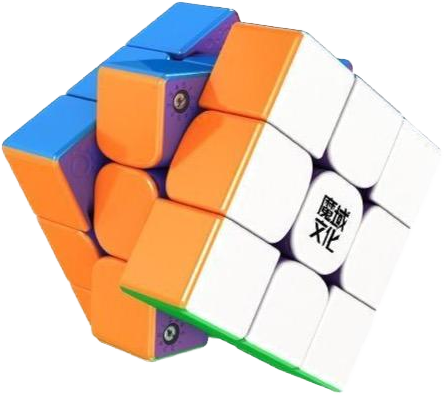 |
Moyu WRM 2021 Maglev – It's purple
|
The magnet settings range around the "weakish" center familiar to WRM cubes, but allow to go down to almost non-magnetic. Given the loose nature of the maglev springs, that makes the cube lose shape during sloppy executions of algs.
But when things go well, this cube is incredible: fast, super smooth, and very, very forgiving. Personally as the cube currently stands, it is too much of a high-risk high-reward cube, but for more accurate cubers it could be a very satisfying cube.
It also look gorgeous: the combination of Moyu's WRM colored outer-shell and internal-color sides make this one look super modern and slick. Hands down the most beautiful stock cube I've ever seen.
A quick update: I eventually got a Core-Corner magnets modding kit and... It changes things A LOT. They add that bit of stabilty that was missing for me, and turn this into the best cube I have right now, maining this thing for CFOP, Roux and OH: "Mom! I don't want to go home!". If you're getting this cube, invest in the core magnets kit.
TLDR: The maglev makes its adjustments range bad, but it's a very fast and very good cube
- Weight & feel – average weight, pieces
feel super-light
- Turning Speed – very fast, it's very easy to
overshoot
- Corner Cutting – it's a wrm, they've been
doing corner-cutting right since 2019
- Magnets – very weak to average adjustments
- Lockups – it locks up when you overshoot, which is
more often than it should. If your turning is accurate then
this won't be an issue
- Sound – average loudness, some clacks when coming
back from an overshoot. Also, (rare) maglev squeaks
- Looks – Gorgeous
- Plastic – Once the (*!$!) frosting wears off, the
plastic feels solid, smooth, high-quality
- Similar-feel cubes – WRM20/21 on weak springs
- Price – 20-25$ + ~10$ for the core magnets kit (buy
it!)
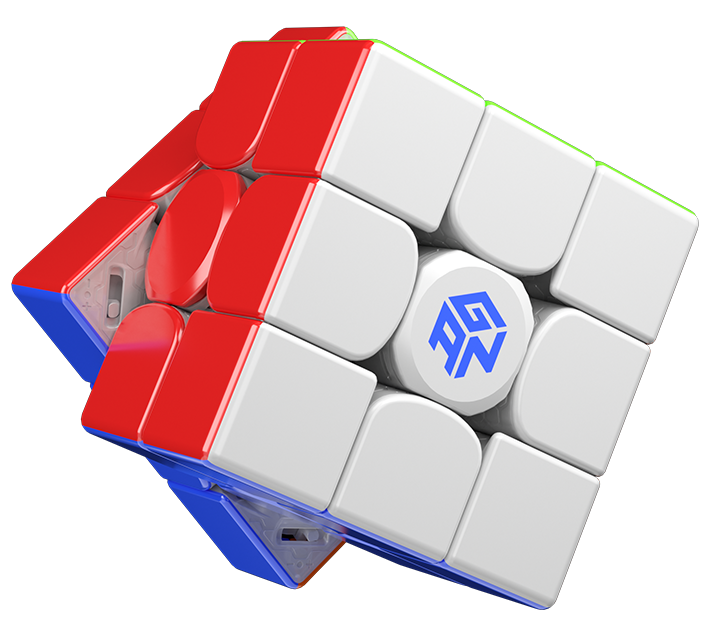 |
Gan 12 M Pro UV – If you can afford it, it's worth
having it
|
The magnets are... weird. Changing the corner setting (only magnet setting that can be adjusted) doesn't change the auto-homing mechanism, and it hardly changes the clickiness feel. It does, however, change how well the cube keeps its shape when abusing it a bit. Given the very light pieces that was an issue for me as I would generate lockups due to the lower layers borking out as I did my algs badly. The "springs" feel very very similar to the first Tengyun (with the good spring swapped): a bit stiff but with no friction. Here the customisation options are much more effective: the cube changes feel g a lot depending on what settings you use (with the travel distance playing more of a role than spring stiffness).
The comparison to the Tengy is relevant given that they are the 2 fastest cubes I've ever been able to use, but in contrast to it, the Gan12 has fantastic cornercutting, and besides the cases in which I mess up my cubeshape during algs, it rarely locks up, which tends to happen to me a lot more on the Tengy. The overall feeling of the cube is very different from other Gan cubes. If the Gan11 was a steroid version of the X/XS that removed most of their flaws while keeping that Gan feeling (at least it felt so to me), this one is a very different cube.
Then there's the UV coating. I had forgotten how it feels to be able to use a cube out of the box without it being a slippery piece of crap until the frosting wears off. This feels great (although the difference compared to a worn out well broken in cube is not huge), it is an added "quality of life" bonus that is just nice to have from the get go.
Which brings me to its price. This cube costs a lot. You can buy 2-3 stellar cubes for the same price. So if money is a concern, just get another cube. If you want something as fast, get a Tengy1. If you want the same forgiveness with inaccurate turning, get a WRM. But if you can afford it and want a cube that is great, this is something you can dunk a month worth of coffee into and be happy with.
TLDR: It is a new Tengy1, with better corner cutting, click magnets and auto-aim
- Weight & feel – beyond light, pieces move
like bubbles on air
- Turning Speed – fast!
- Corner Cutting – stellar
- Magnets – average to strong depending on setting,
and they have aim-bot
- Lockups – the very long core magnets seem to bump
against the core casing making it have weird lockups, but it
doesn't happen to everyone
- Sound – God this thing is loud. "Please, would you
mind stopping that noise, we're 8 seats away and we can't hear
each other talk"-loud, sound is very crunchy
- Looks – Shiny UV surface, sharp bevels and clean
internals. This thing is flashy and beautiful.
- Plastic – Very crispy, but also flimsy, feels like
you could break it if you squeeze too much
- Similar-feel cubes – Dayan Tengyun v1, Gan 11 M Pro
- Price – 70-80$
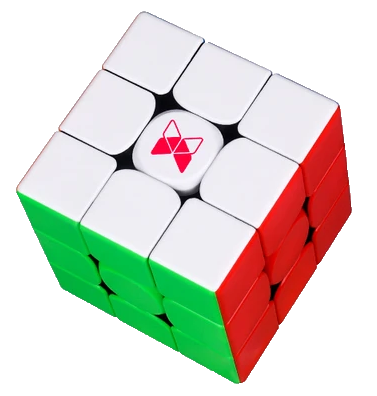 |
XMan Tornado v2 – Very quiet, very modest, very good
|
The customization is one of the clearest, most visible, most easy to change that I've seen in a cube. If you've ever used an adjustment system, you know the pain of finding that specific direction where the specular lights hit the cube just so and you can finally read the values on the spring/magnet. You will not have to do that for the Tornado. You do need a wonky tool in the shape of a bident, but even that is, by itself, a work of art: not only does it contain within itself a multitude of interchangeable screwdriver heads, they all have small magnets that clip to the inner container or to the driver itself. I find myself having only that in my bag and know that I have the cubing equivalent of a swiss-army knife at my disposal.
The cube is smaller than usual (in relative terms) at 54.5-ish mm, which works out well for my hands. It turns very smoothly and solidly. Corner-cuts at 70° (not that you ever need that) and does it in that gradual way that is not a violent snap. It doesn't really lock up, although it might hiccup a bit when turning badly, but never in a way that interrupts your alg executions. The overall feeling is of smoothness in turning, in sound, in looks.
And oh the quietness : I travel a lot, and have had many people coming up to me and asking me to "stop that noise". Never with the Tornado v2. It is also something I can cube with when visiting friends or family, as it doesn't interrupt or disturb the conversations or film-watching that might be going on.
TLDR: A very smooth cube I find myself using all the time when traveling as I know I won't be bothering anyone, and still have a top-performance cube
- Weight & feel – light and solid, pieces
turn easily
- Turning Speed – average to fast
- Corner Cutting – Fantastic compared to older
cubes, good vs. newer ones.
- Magnets – good range of values from rather weak to
more than average
- Lockups – This thing is smooth all over, but it does
get its iffy locks sometimes
- Sound – SO QUIET! Sounds a bit squishy/liquid
- Looks – a kind of a "sharper Gan", with black
internals and flatter edges
- Plastic – Solid and so very smooth
- Similar-feel cubes – Rather unique, but could remind of a more solid older Gan 356
- Price – 20-25$
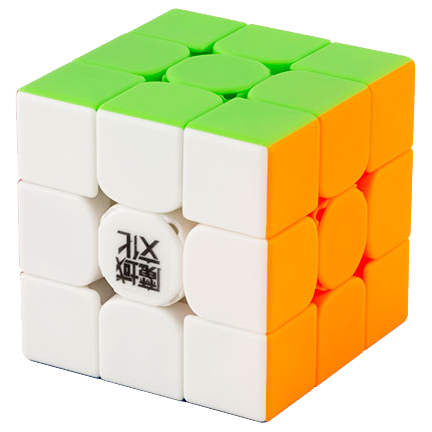 |
Moyu WRM (2019) Maglev – Because Why Not!
|
I've come to be in the Fans-of-the-WRM bandwagon lately as I only got ahold of one the past few months, and it has rapidly become one of my favorite cubes (although my favorite WRM remains the WRM 2020).
It is shiny, it comes from an era where slippery frosted surfaces were not the semi-ubiquitous mind-virus that infected all cube manufacturers the past 2 years. It feels a bit blocky and with the solid plastic that used to be used in 2019. It is not a light puzzle, but it doesnt ask for much effort to turn its faces. Corner cutting is what you'd expect from a modern Moyu cube, You can get it to lock up if you really try, but it's difficult, and wont ever happen mid-solve.
While ranting about the terrible, terrible thing that the newest WRM (2021 maglev) is (see review above), a brilliant mind (thank you Sevilz!) suggested to swap the maglev for normal springs. And in the same digital breath said "and put the maglev in the Wrm19". So I did. Oh boy.
Maybe it's the fact that the cube is just a tiny bit larger, heavier, "bulkier", which makes turning the faces accurately easier, but I find myself without any of the issues I so despise on the WRM21maglev. The fact that the RS3M 2021 (maglev) also didnt give me problems and is ALSO a blocky/bulky cube, makes me think that maglev could be better on heavish cubes rather than light ones.
The WRM19maglev is now just faster without losing any of its controllability and smoothness. The "spring" compression in its default value is stiffer than with stock springs and makes me think of the Tengyun (v1) with the replacement (golden) springs (as if the whole face is solidly floating in the air, it turns very fast but can't distort too much). In all honesty, maybe just cleaning it out properly, relubing the thing and putting it on the looser settings would likely achieve something very similar, but I like to think that the wind of modernity is bringing a new life to this old cube.
Funnily enough I haven't heard it squeak once yet, so maybe it's not the maglev per se, but the combination of maglev and other pieces that make them squeak. This one is silent as... well it's still the WRM19, it's by no means a quiet cube. The lack of nuance in the tighter settings from the maglev, that irked me so on the WRM21) is not an issue, as this cube seems to work well when not too tight.
I think I'm gonna keep it like this!
p.s. I now have TWO cubes that are better than before: I like the WRM21wasmaglev way better as it is now, on a medium tightness that was very hard to achieve with magnets.
TLDR: A great cube that compares well or better to any of its younger iterations, and the maglev works very well with it.
- Weight & feel – Average weight, solid,
blocky but very easy to turn
- Turning Speed – Fast!
- Corner Cutting – stellar
- Magnets – Non adjustable, average strength, works
very well with its speed
- Lockups – nuh uh.
- Sound – Average volume, sounds more plasticky than
most cubes
- Looks – It definitely looks retro, with those
center-cap holes making it very distinctive and dated. But
retro is very fashionable nowadays!
- Plastic – Solid and so very smooth
- Similar-feel cubes – Moyu WRM20/21(non maglev), Dayan
Tengyun (v1)
- Price – 30$ plus a Maglev cube (e.g. RS3M 2021 for
10$)
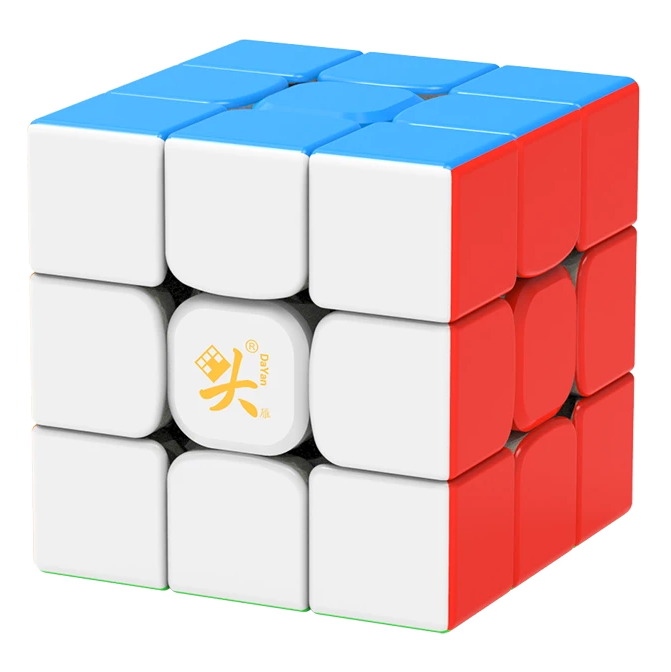 |
Dayan Zhanchi Pro M – That's how cube adjustments
should be!
|
The plastic and shape feels a lot like the Guhong, with very sharp edges and hard plastic: a contrast to the Tengyun 1/2 with rounded edges and softer plastic (and sound). It is reasonably quiet, but can clack very loudly if the turning is not too accurate.
All in all, for once, settings let you truly go through a range of different feelings, rather than having a ton of options to essentially get the same cube in very slightly different flavours, all of which suck (thank you Tengy v2). It's also not a clicky mess with magnets that although technically weak, are impossible to not feel strongly (thank you Guhong v4).
TLDR: It's a very good cube, with a range of achievable settings that are actually useful and diverse.
- Weight & feel – light, and depending on
settings pieces feel very light as well
- Turning Speed – fast! average! Set it how you like
it!
- Corner Cutting – from good to very good
- Magnets – strong! weak! (you catch my drift)
- Lockups – not really, the cube is very forgiving, and
if you don't mind an auditory slap when you mess up, this
thing doesn't really lock up
- Sound – Quite silent as most Dayan tend to be, until
you turn like an impaired chimp and it slaps you. Soft
"liquid" sound
- Looks – sharp, very similar to the Guhong v4 (only
the color of the logo, or picking it up and turning it let you
know which one it is)
- Plastic – Solid, almost oily
- Similar-feel cubes – A lot of different cubes
- Price – 20-25$
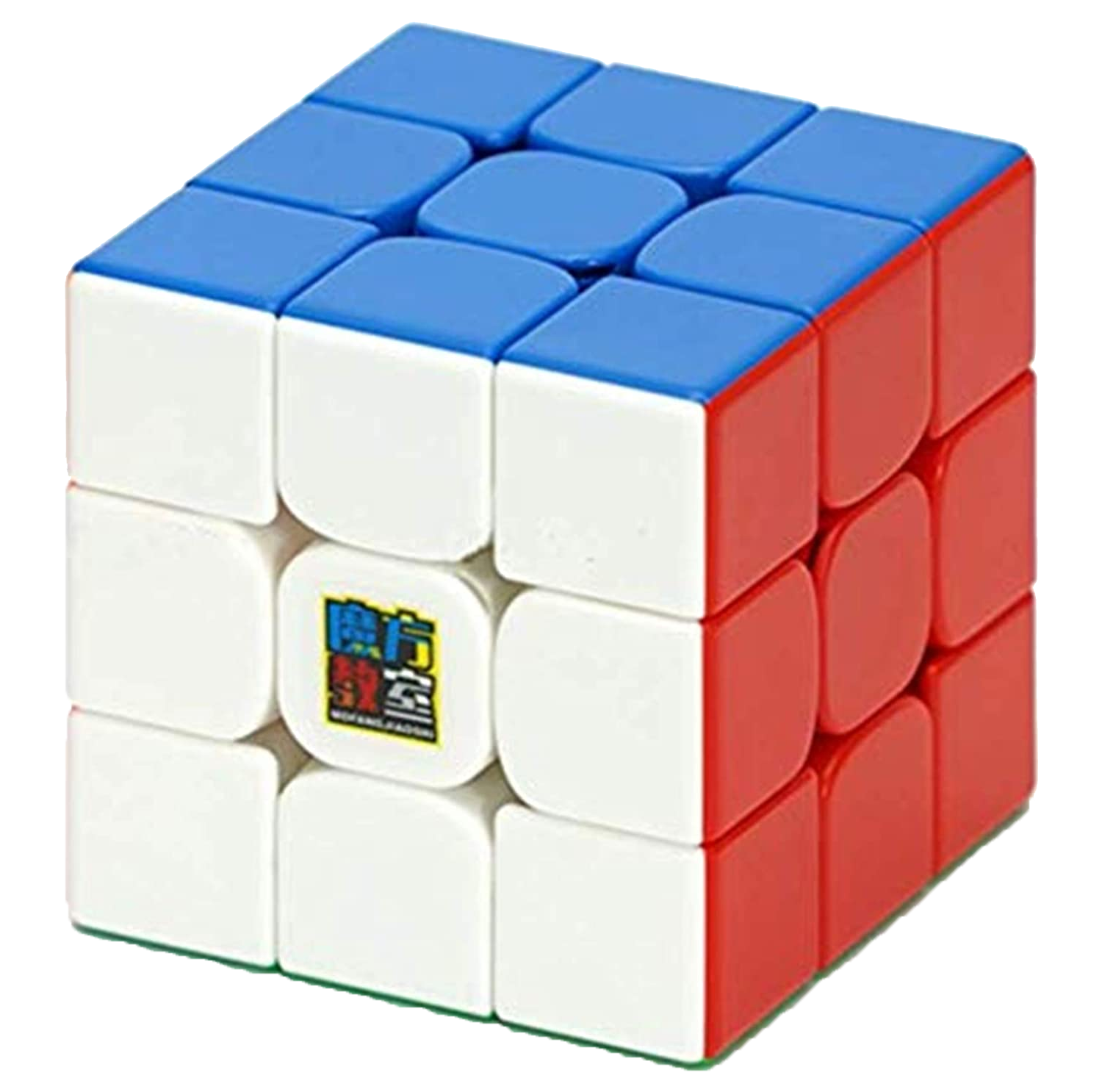 |
Moyu RS3M 2021 – it's identical to the RS3M2020, so
it's great
|
The pieces are identical, same plastic, same mold, same shape or weight. You can interchange them flawlessly with the Rs3m2020. The friction is identical (the total friction of the springs is so minimal compared to the friction of all the pieces themselves that if you can "feel a difference" you're lying to yourself). The "springs" are... a bit looser: the Maglev lets you range on a slightly looser curve than the springs would, but mostly it's indistinguishable. If I didn't hear the Maglev squeak from time to time, I wouldn't be able to tell if it's the 2020 or 21 version.
As for its performance, it's a RS3M, it is fast, blocky, corner-cuts like magic, never (or almost) locks up and feels like a solid flagship cube. If the feeling was that the rs3m was too good to be as inexpensive as it was, the attempt to raise its price with this new iteration (a 40% increase) still leave it ridiculously cheap for the sheer quality of solving that it brings. If you're going to spend less than 20$ on a cube, this is the only cube you should really consider buying.
* Yes, maglev squeaks for some weird reason: did Moyu want to keep the signature spring squeaks from its predecessor?
TLDR: This cube should probably not exist, but it does, so we're happy. Buy one.
- Weight & feel – average weight, pieces
feel very blocky
- Turning Speed – fast
- Corner Cutting – stellar
- Magnets – average, perfectly fine
- Lockups – it can hard-lock if you try to cornercut
too much (think 70°)
- Sound – Clacky! This thing is NOT quiet. Also the
maglev squeaks
- Looks – the rs3m2020 has redefined the look of the
stickerless cube with colored internals and it looks great.
The logo looks god-awful.
- Plastic – Solid, blocky, and when the frosting
finally wears off, very nice
- Similar-feel cubes – RS3M 2020 (duh)
- Price – 10$
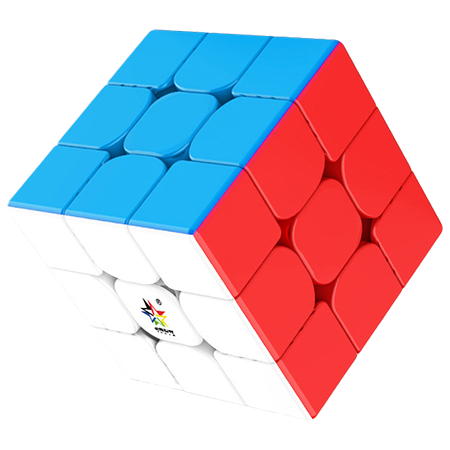 |
Yuxin Little Magic M – the little cube that could
|
While it doesn't have adjustable settings, besides the screw for travel distance (which should be tightened from stock setting), it allows to find a good balance between stability and speed Mind you: if you're considering this cube, its "speed" is not going to be what makes you slow. It's plenty fast enough.
In terms of performance it's a great cube, it just... feels cheap. To the touch the plastic is not great, it looks and feels like a budget toy. But if you can get past that it will surprise you by how well it works.
It is also fantastically quiet, with a buttery sound and feel that reminds me of the Tengyun v2. For people cubing in social settings or public transportation that can be a very positive plus.
TLDR: It feels budget but performs like a much more expensive cube. If you need something quieter than the RS3M202x, this is a good alternative
- Weight & feel – average weight, pieces
have inertia when turning
- Turning Speed – average
- Corner Cutting – good, more than enough for
anything you really need
- Magnets – average
- Lockups – youit can hard-lock if you try to cornercut
too much (think 70°)
- Sound – Very quiet and with a buttery sound that
remains very discreet
- Looks – about as ordinary as a stickerless cube
looks, the glossy plastic is a bit translucent and not in a
good way
- Plastic – it feels cheap and very "plasticky"
- Similar-feel cubes – Dayan Tengyun v2
- Price – 8$
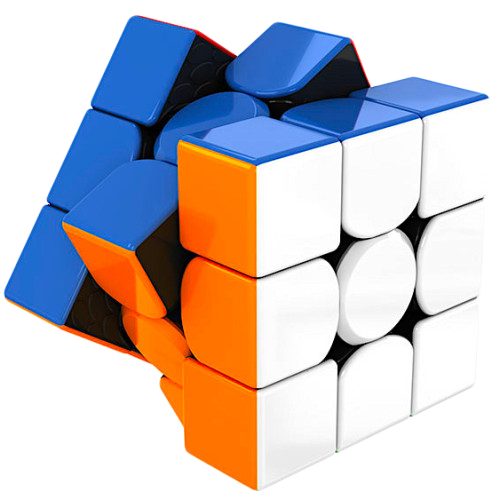 |
DianSheng Solar S – A budget cube that is more
expensive than a lot of better cubes
|
The plastic feels cheap, with uneven cuts of the piece covers, some jagged edges that cut a bit into the fingers (those will probably wear off with time). It sounds like cheap plastic scraping against cheap plastic, but it is not too loud. It has no customization besides tightening the screws to reduce travel distance. This is not a surprise for a budget cube, but you could be paying half as much for a Meilong M and have a far superior cube without customization, or slightly less for an RS3M or YLM that perform much better than the Solar S.
In the end it's a modern cube with relatively forgiving corner cutting, but who loses shape easily and locks up.
TLDR: If you want a Dayan Guhong v4 that doesn't break for roughly the same price, go for it! Otherwise get a YLM, Meilong or RS3M instead.
- Weight & feel – average weight, pieces
feel moderately heavy to turn
- Turning Speed – average once you tighten it enough
to make it usable
- Corner Cutting – average, generates some
lockups during solves
- Magnets – strongish, non-adjustable
- Lockups – happen relatively often
- Sound – not particularly loud, plasticky
- Looks – a clone of older Gans, with glossy plastic
(yay!) that looks cheap (nay!)
- Plastic – unevenly cut, pieces feel sharp
- Similar-feel cubes – Dayan Guhong v4
- Price – 12$
Basilio Noris is a PhD in machine learning with a passion for cubing, data visualization and astrophotography. He did his academic research on the early diagnosis of Autism, bridging psychology, neurology and data science. He now runs a company doing analysis of human behavior in retail and manufacturing environments. For some reason, he seems to find time to do things under the mistaken impression that he knows anything about cubing.
